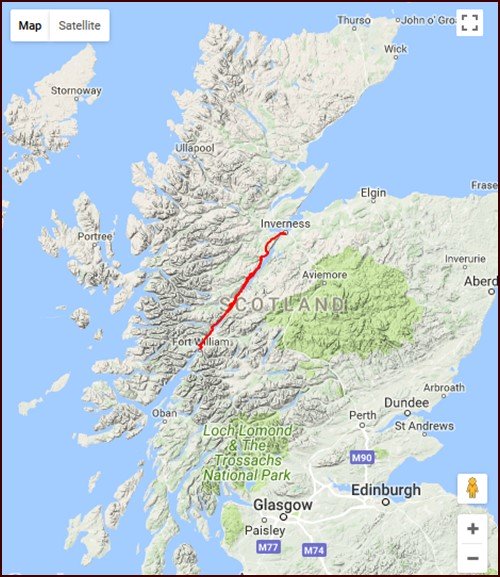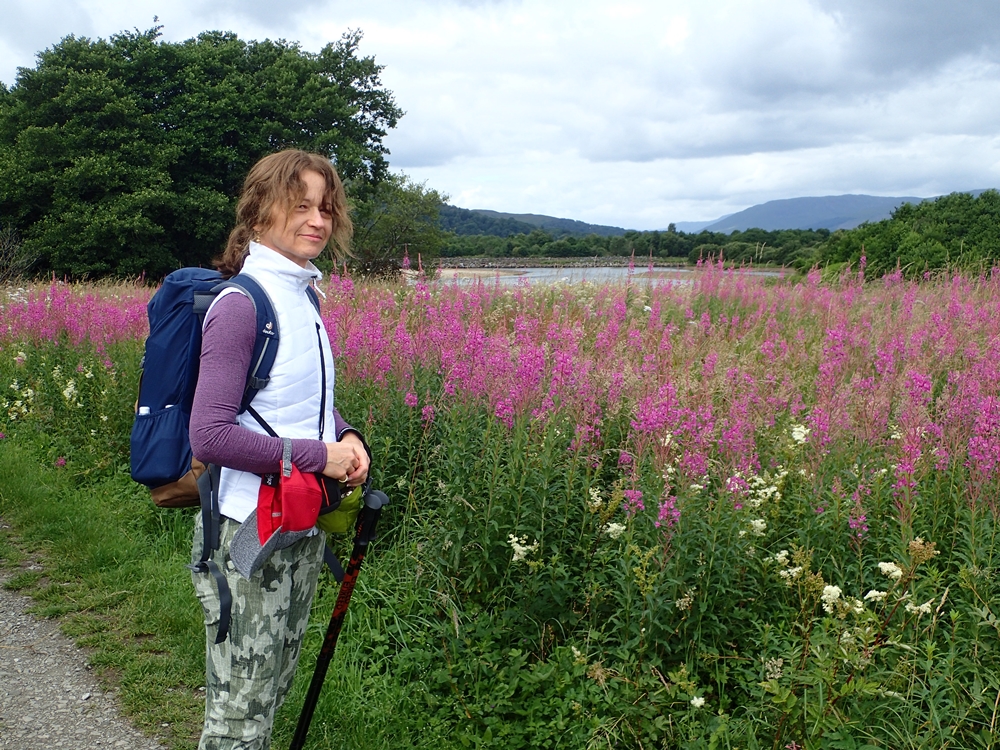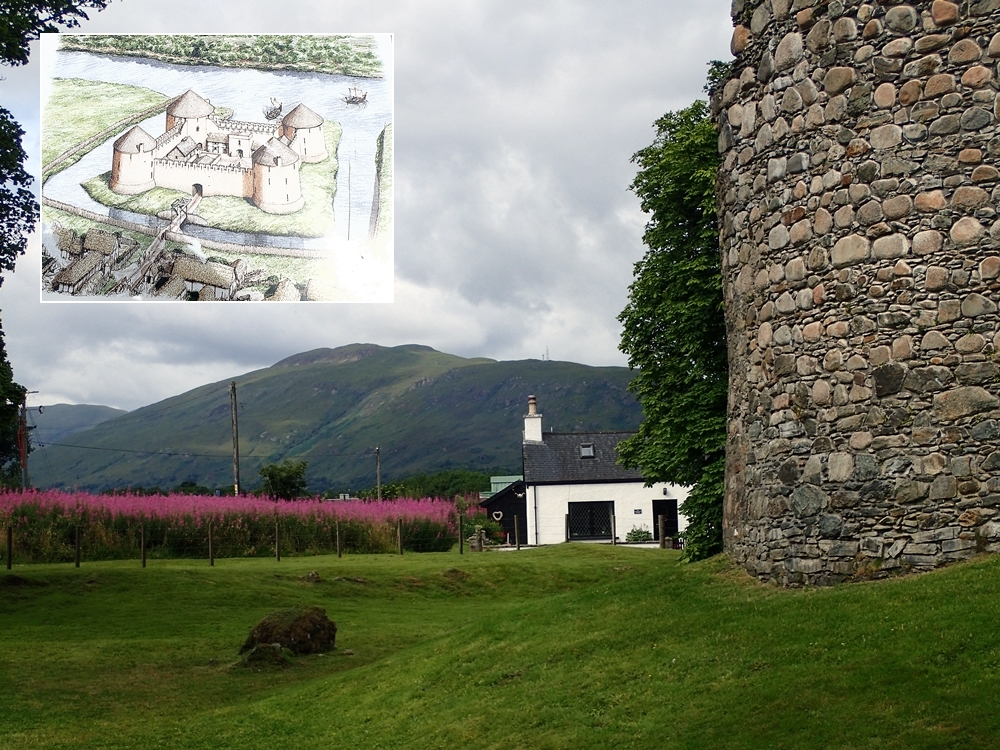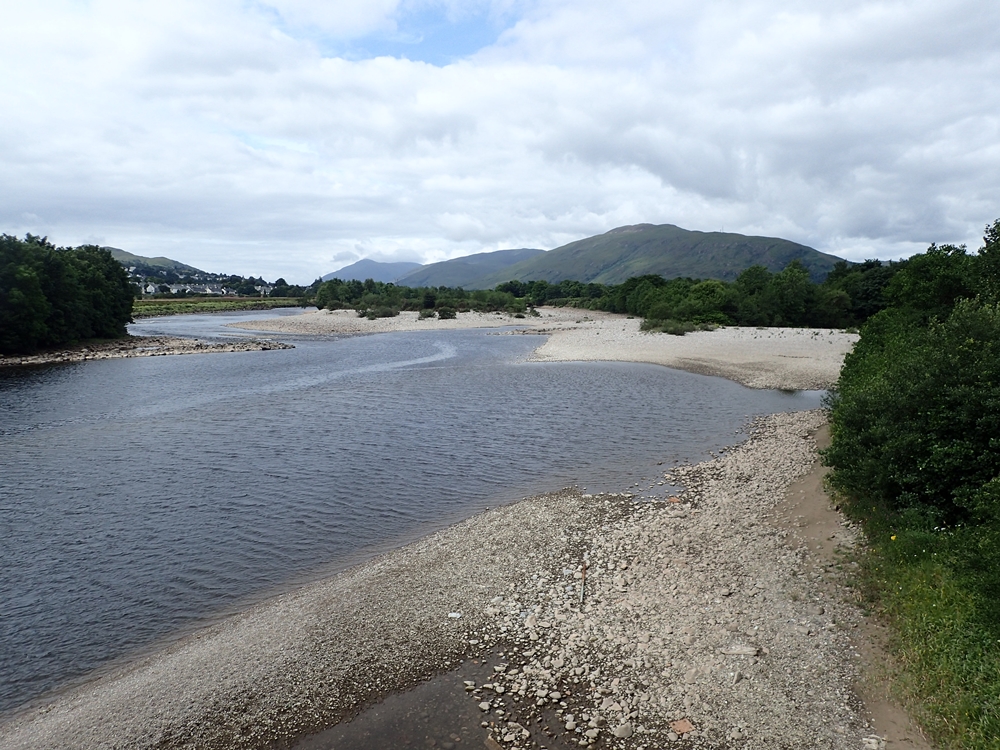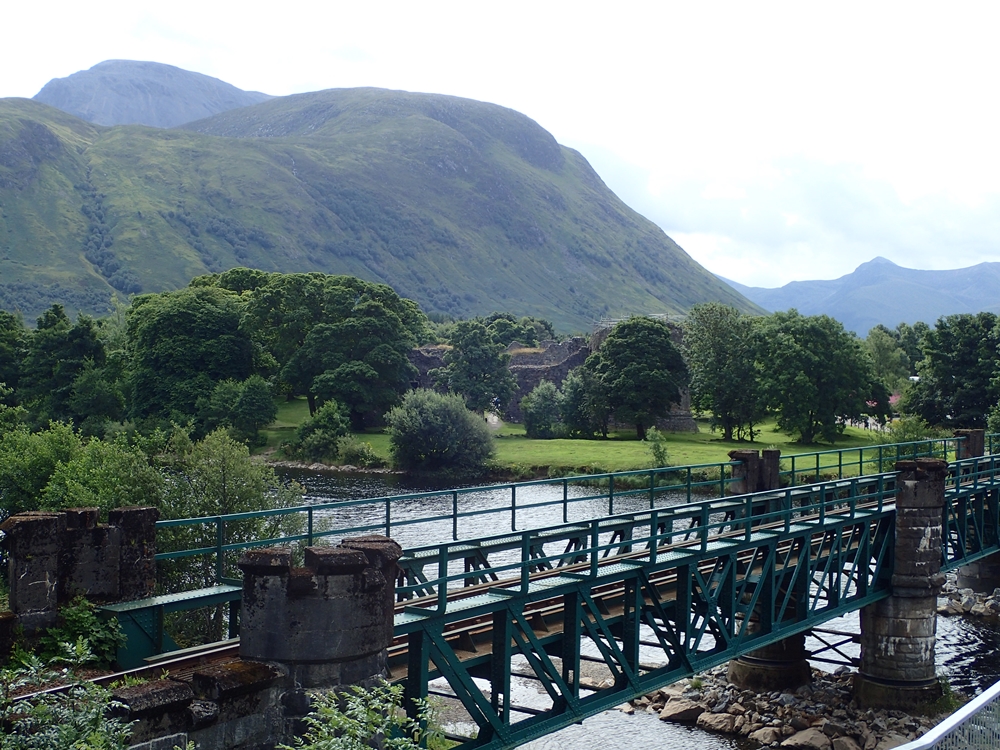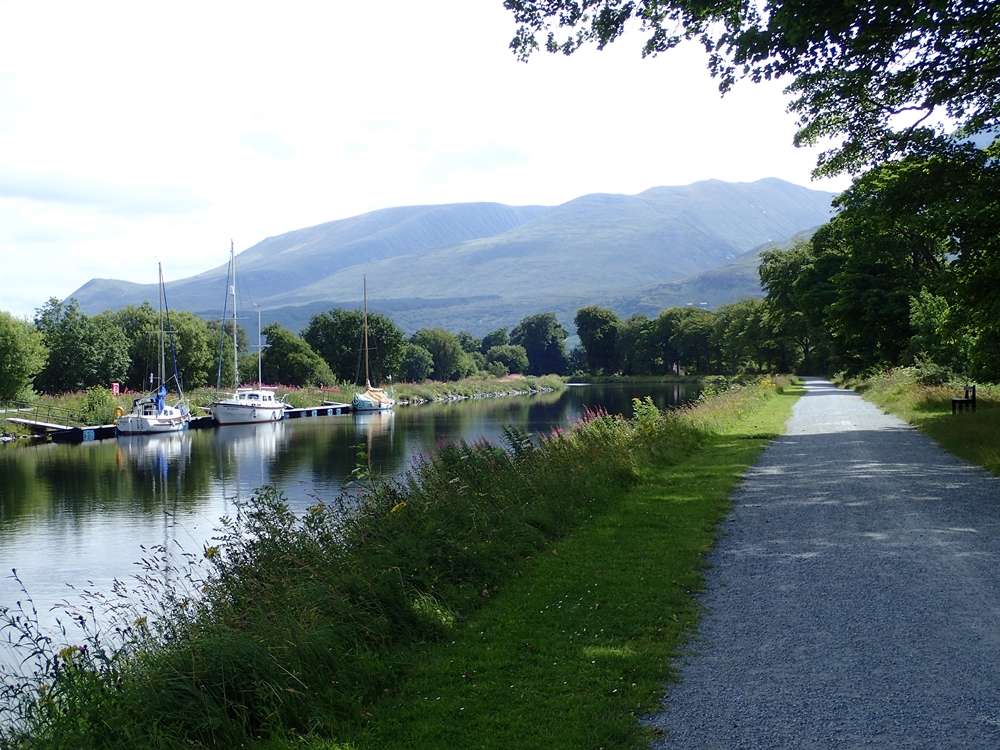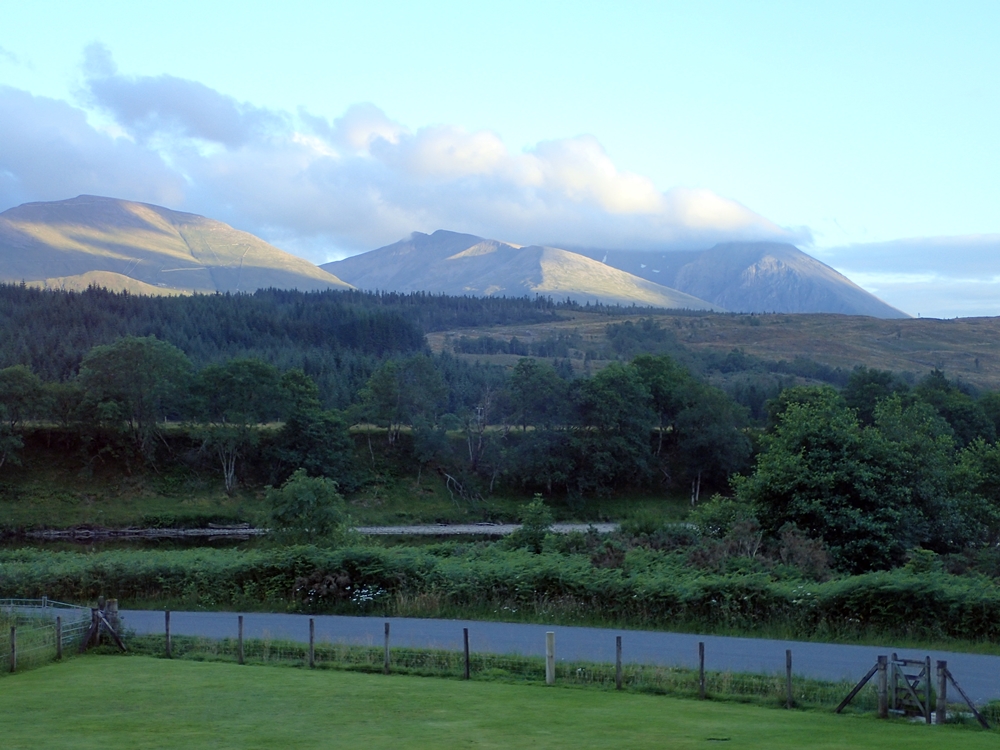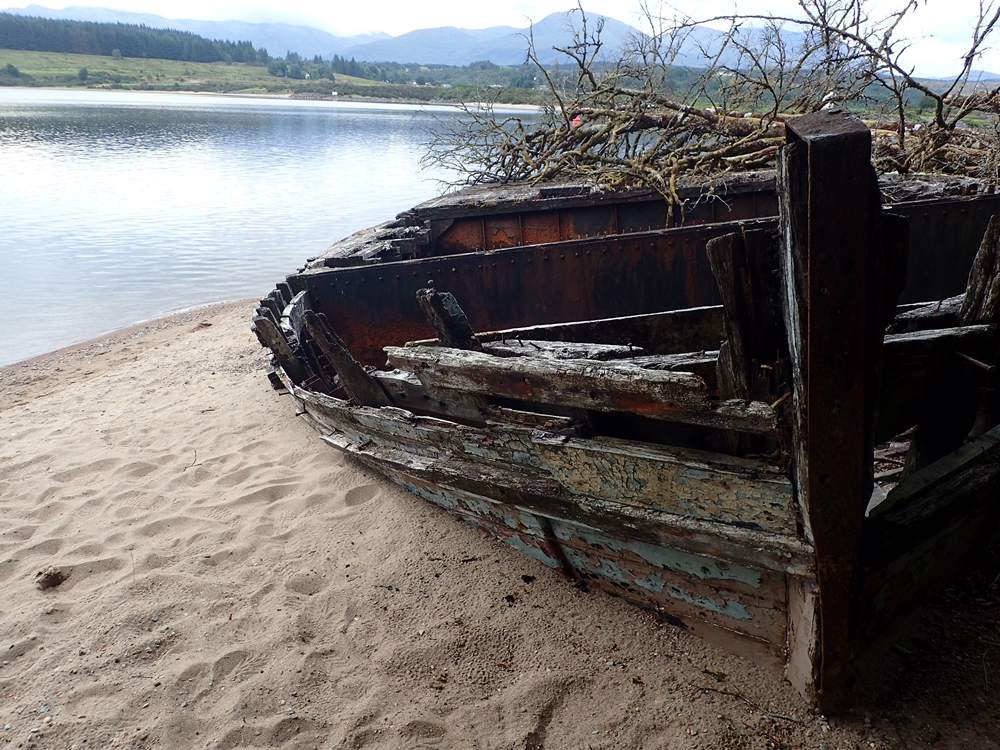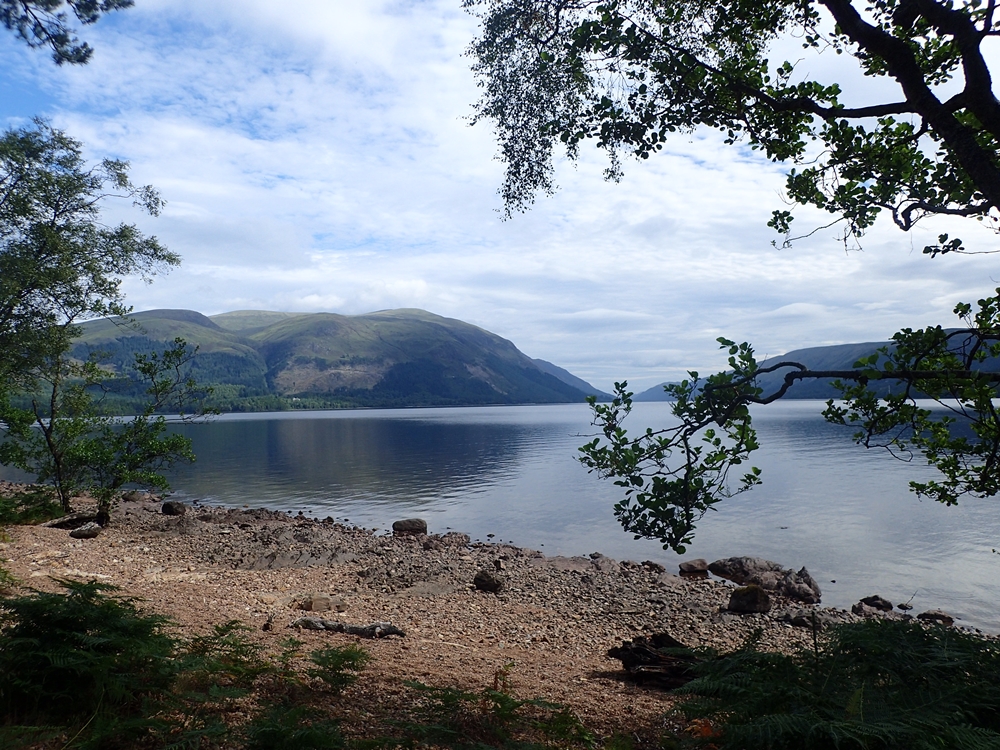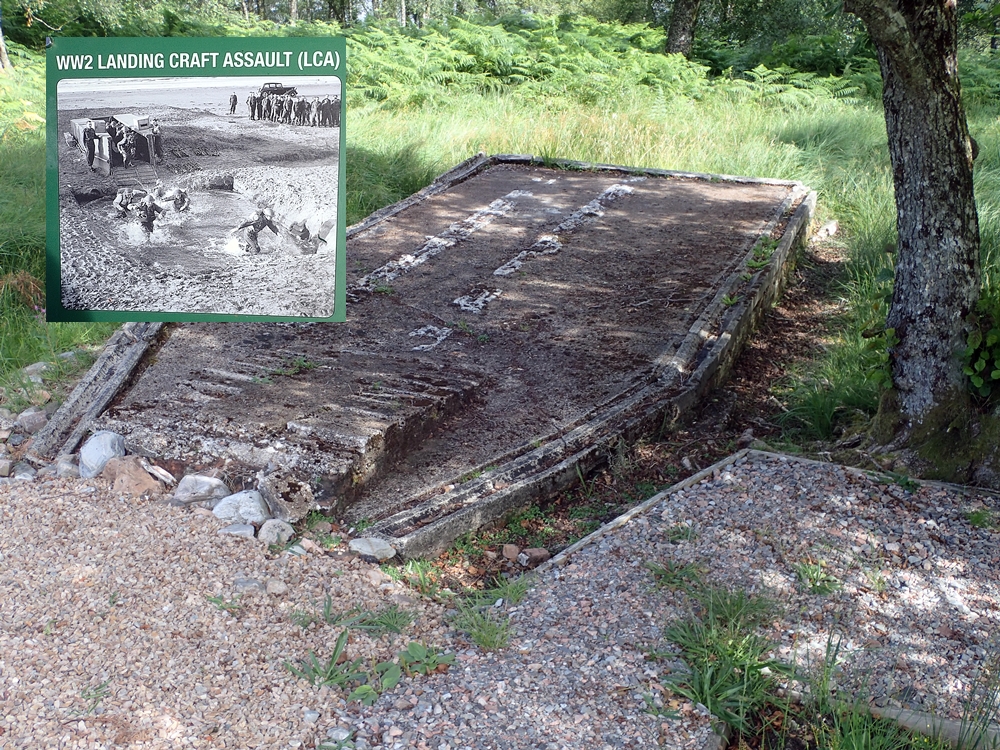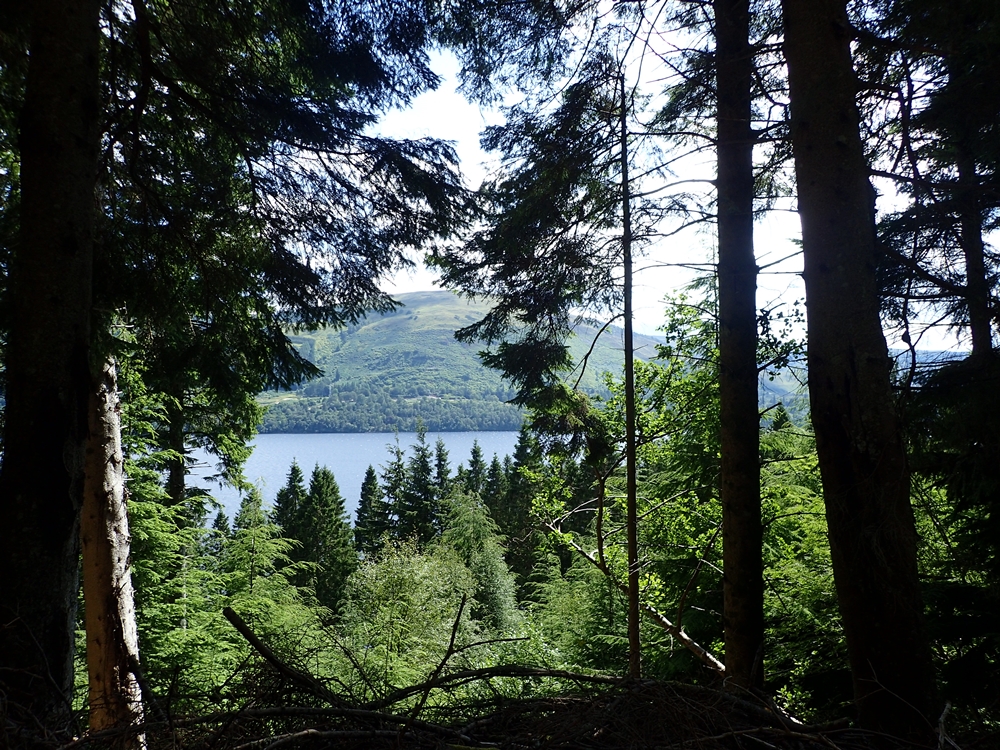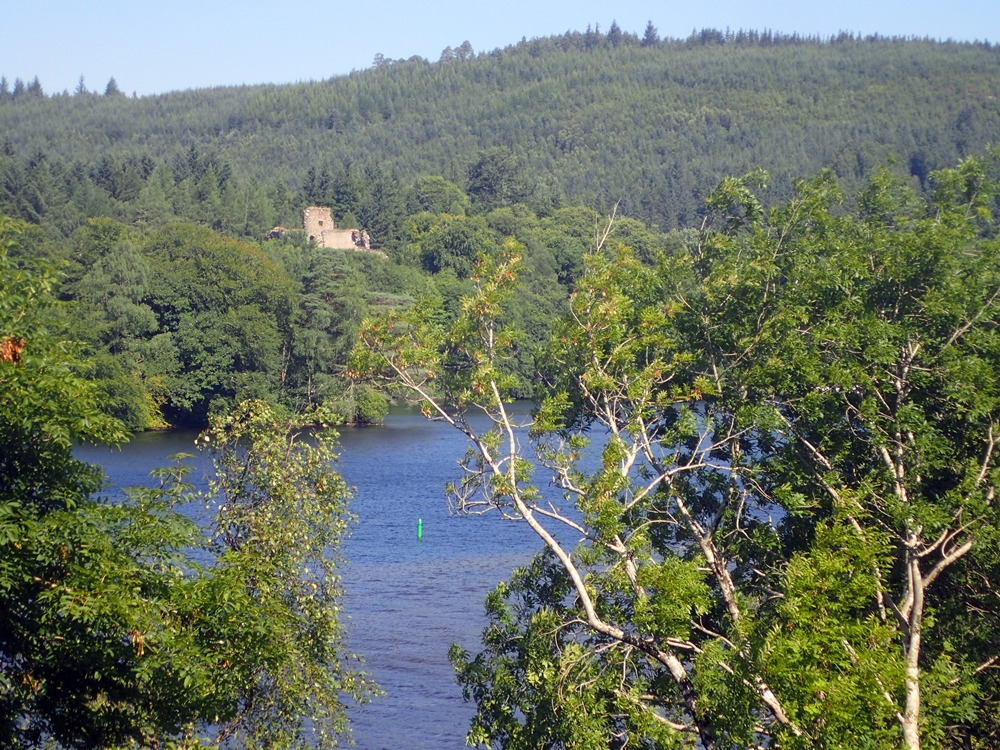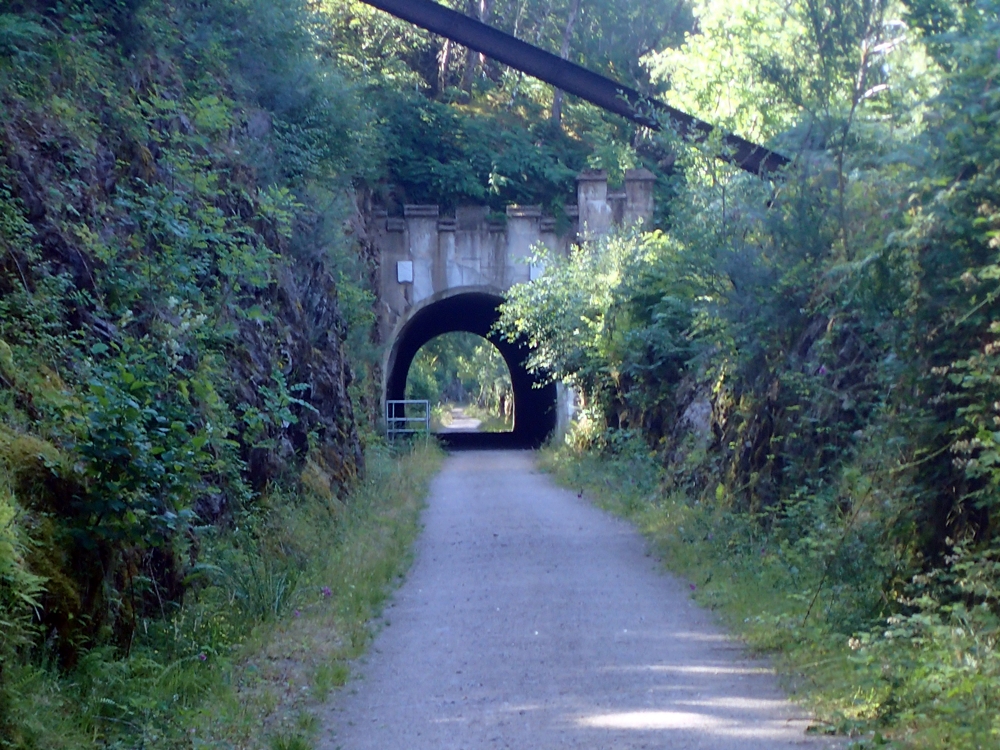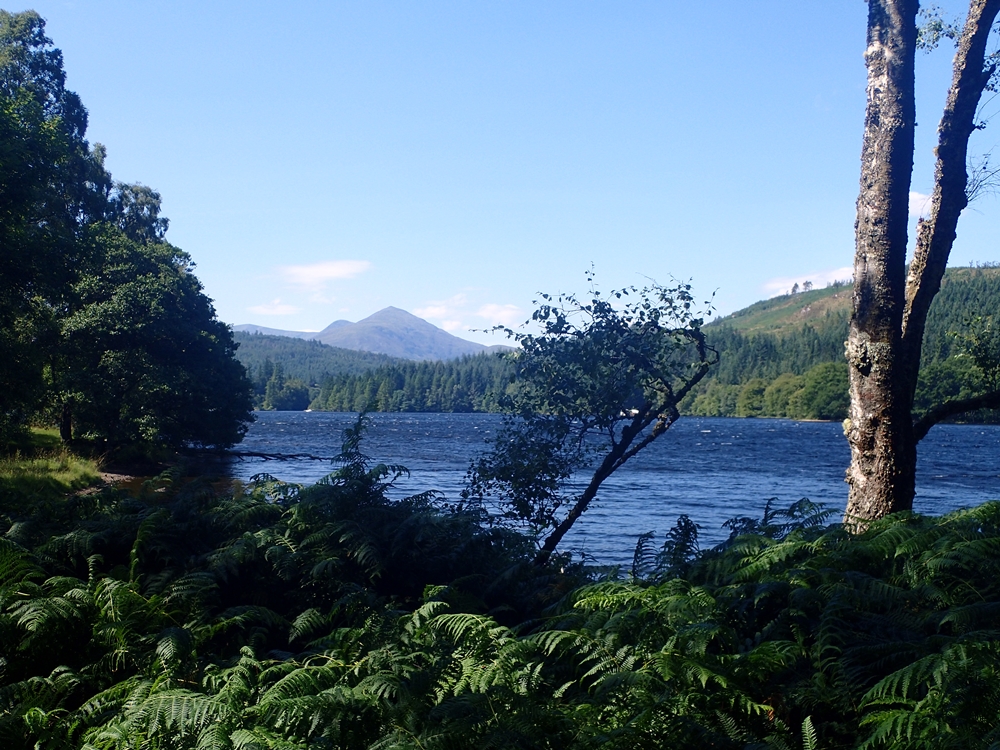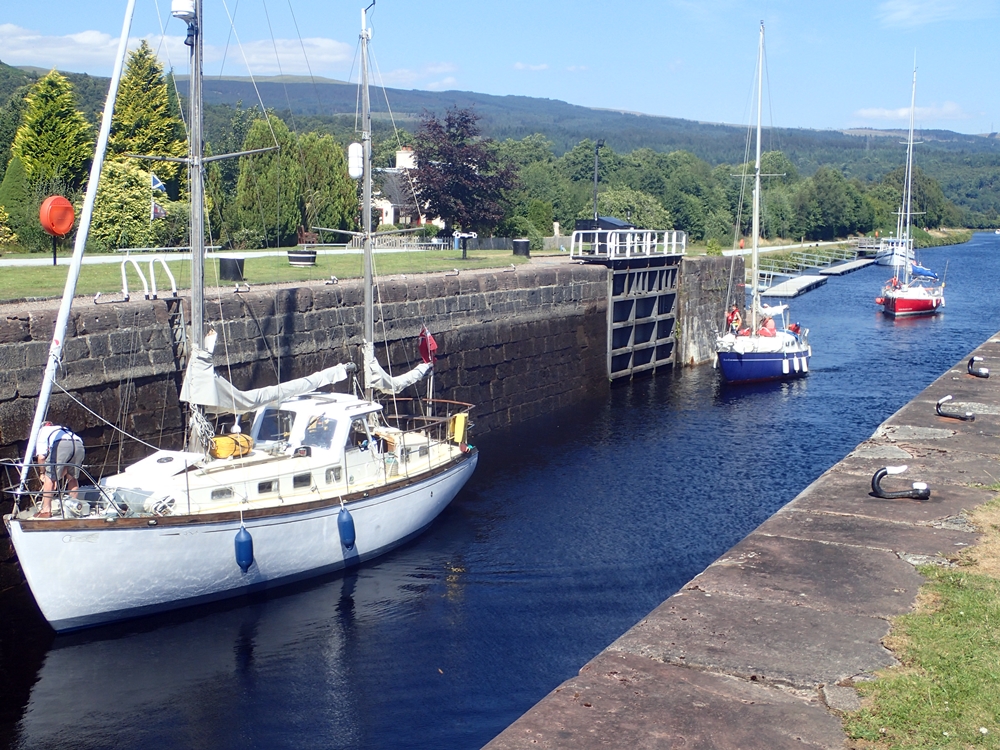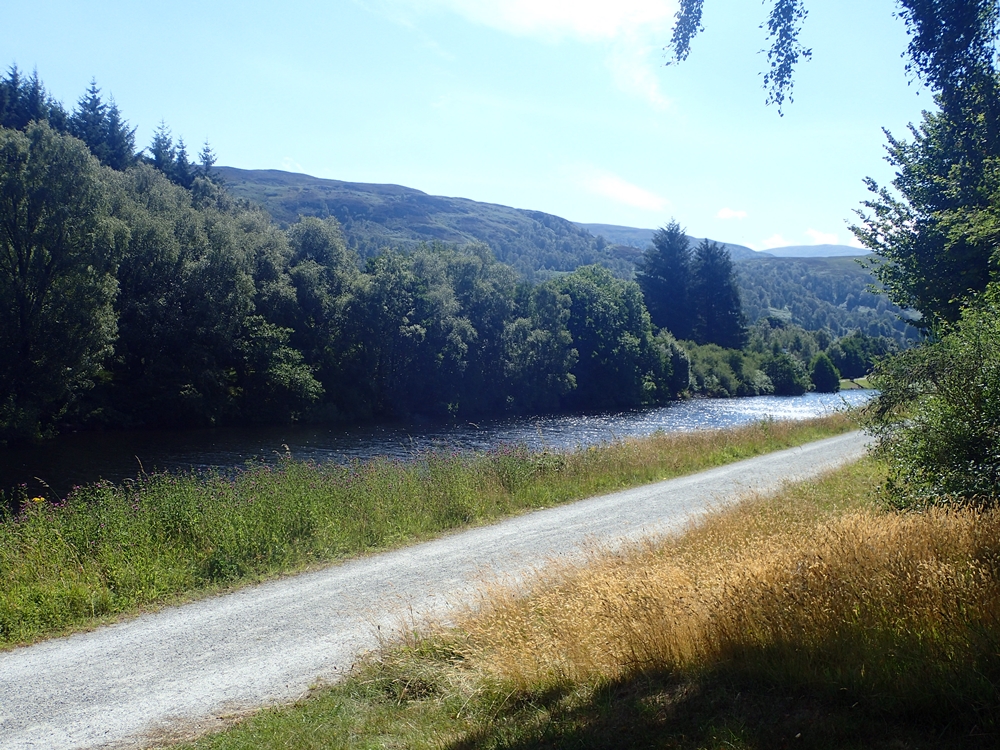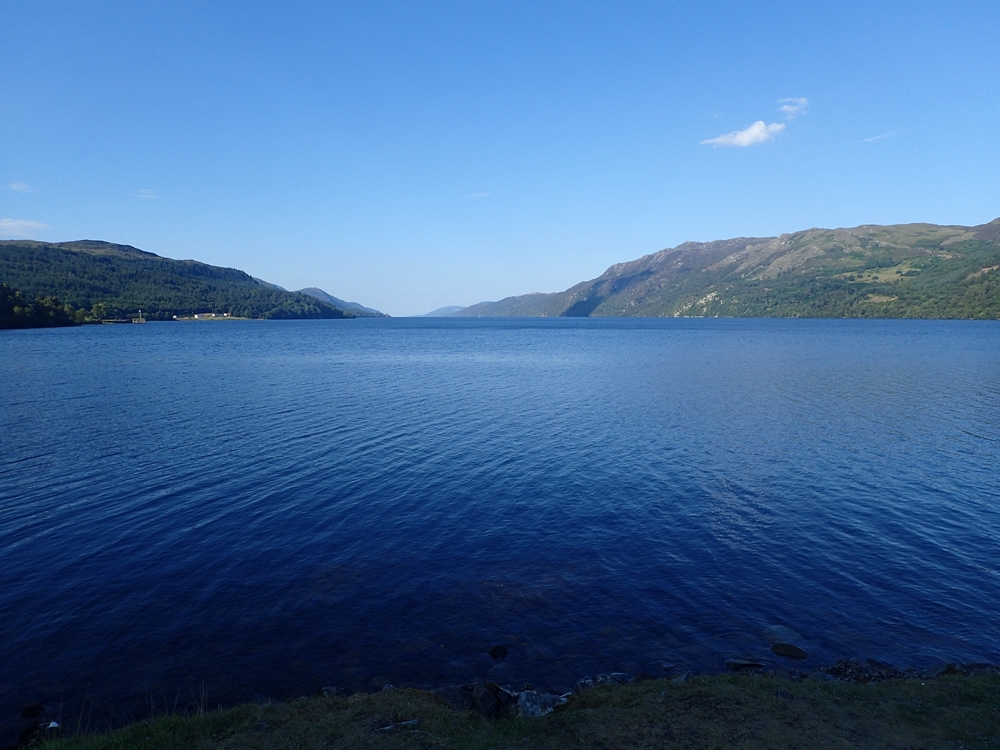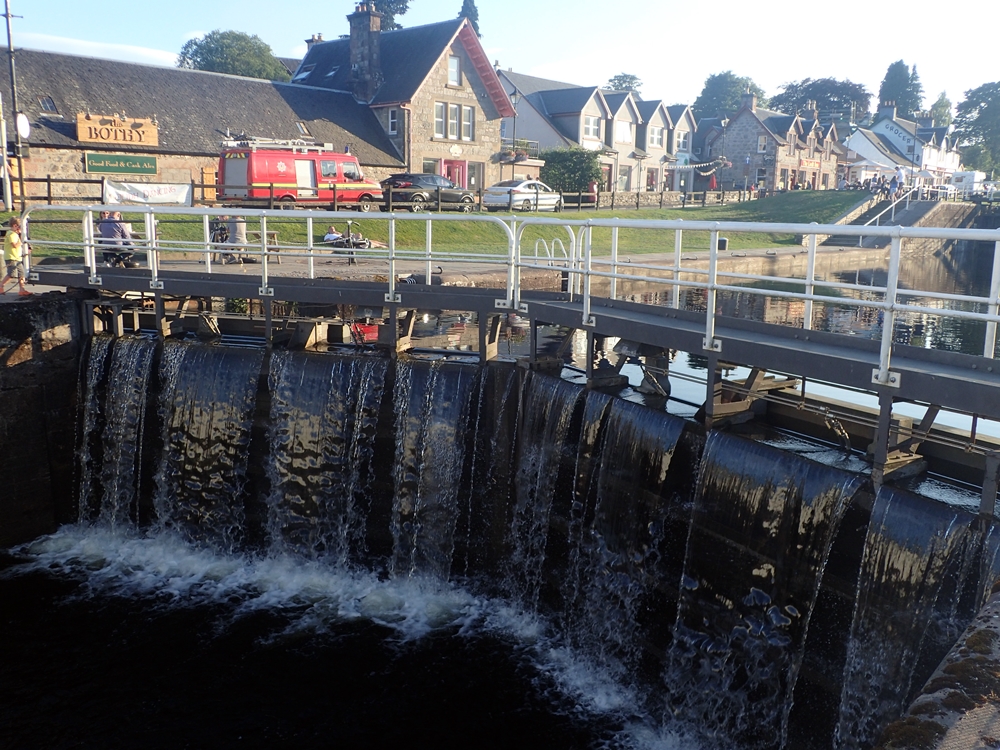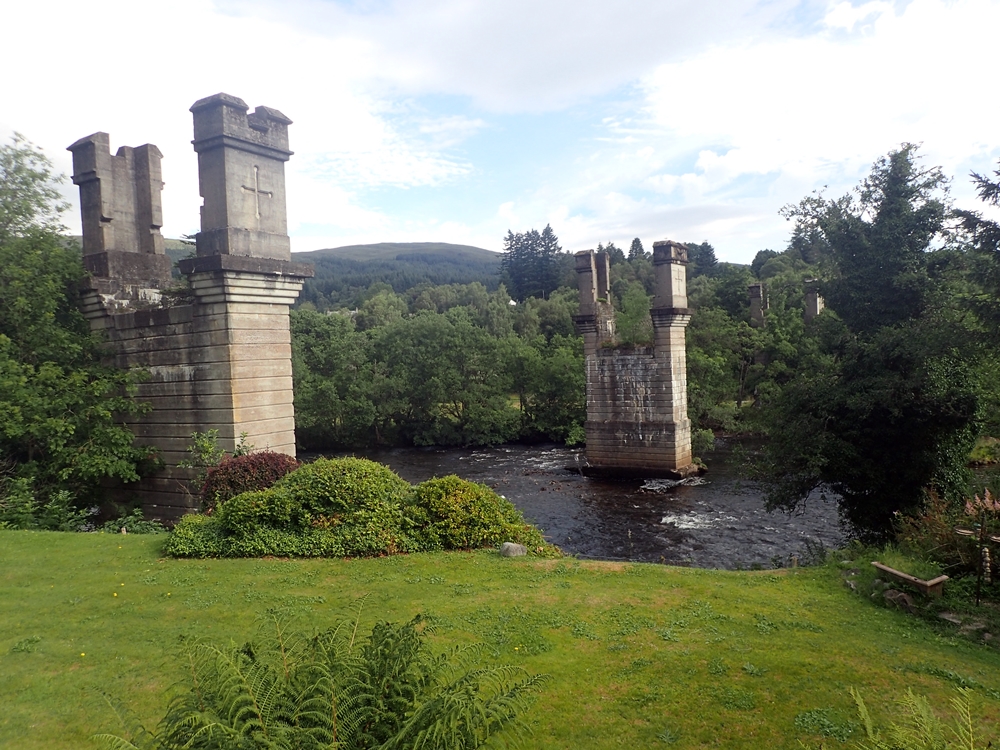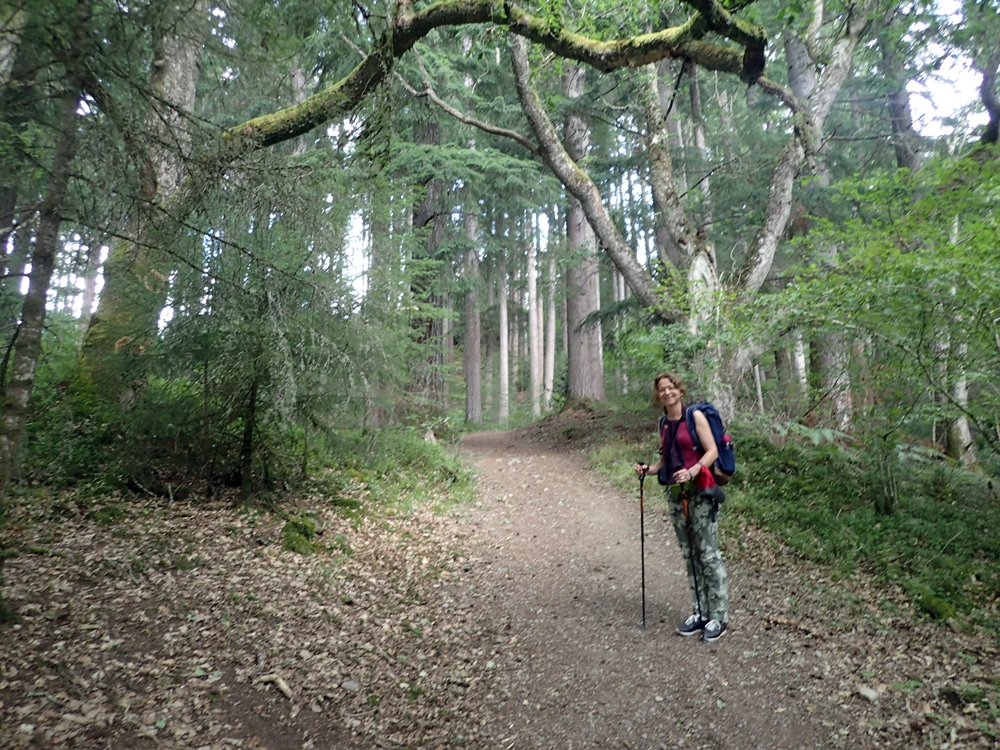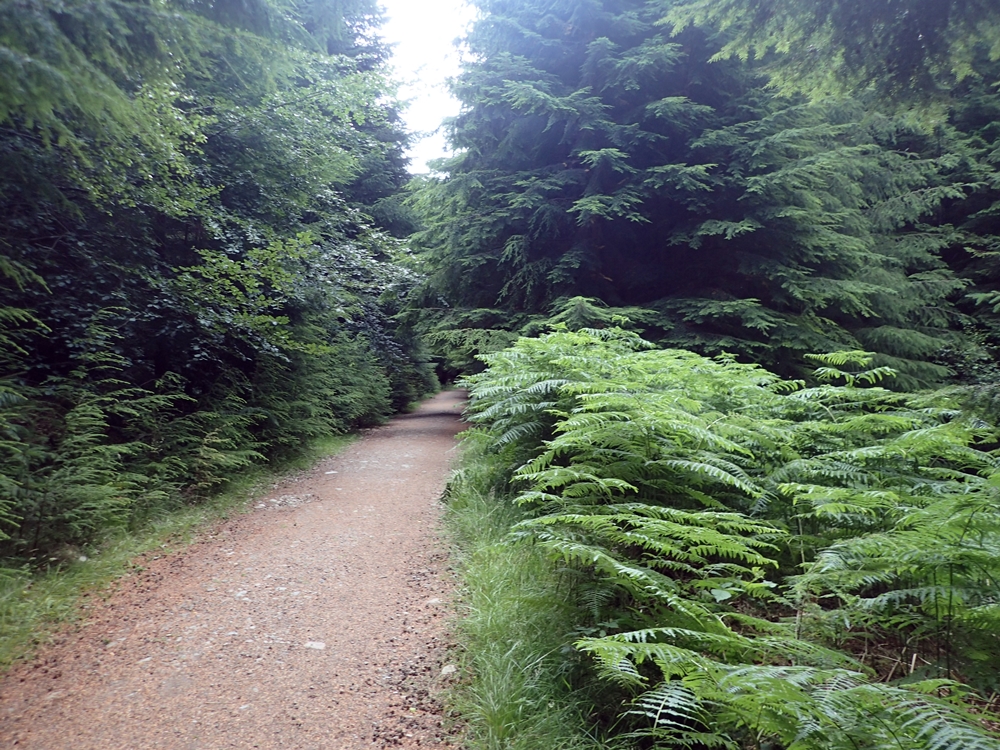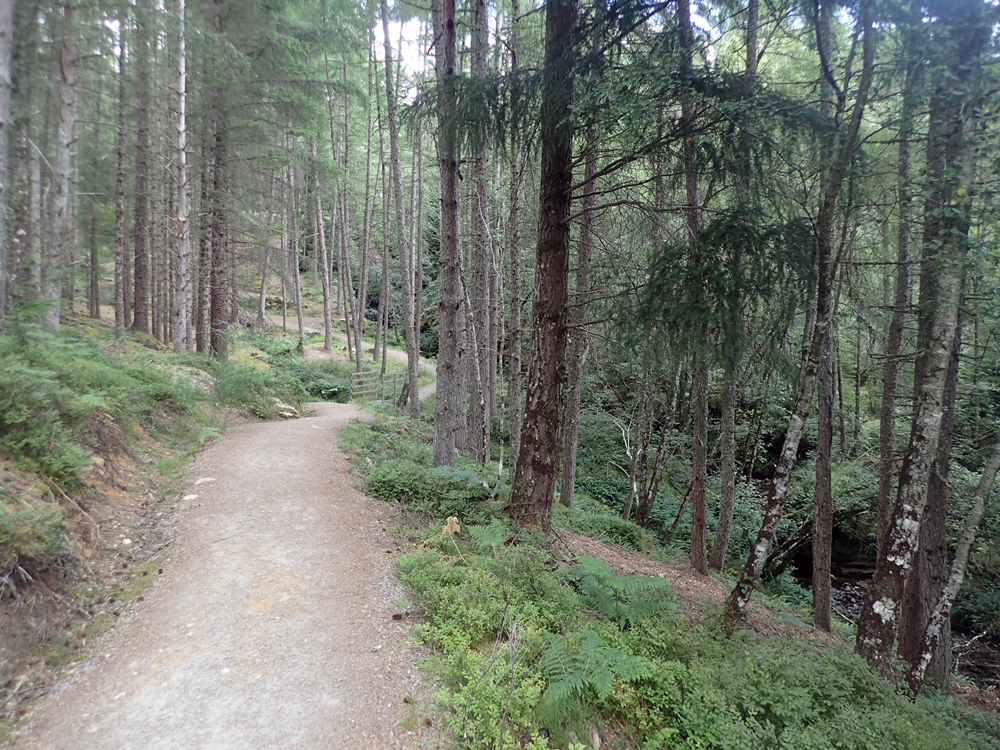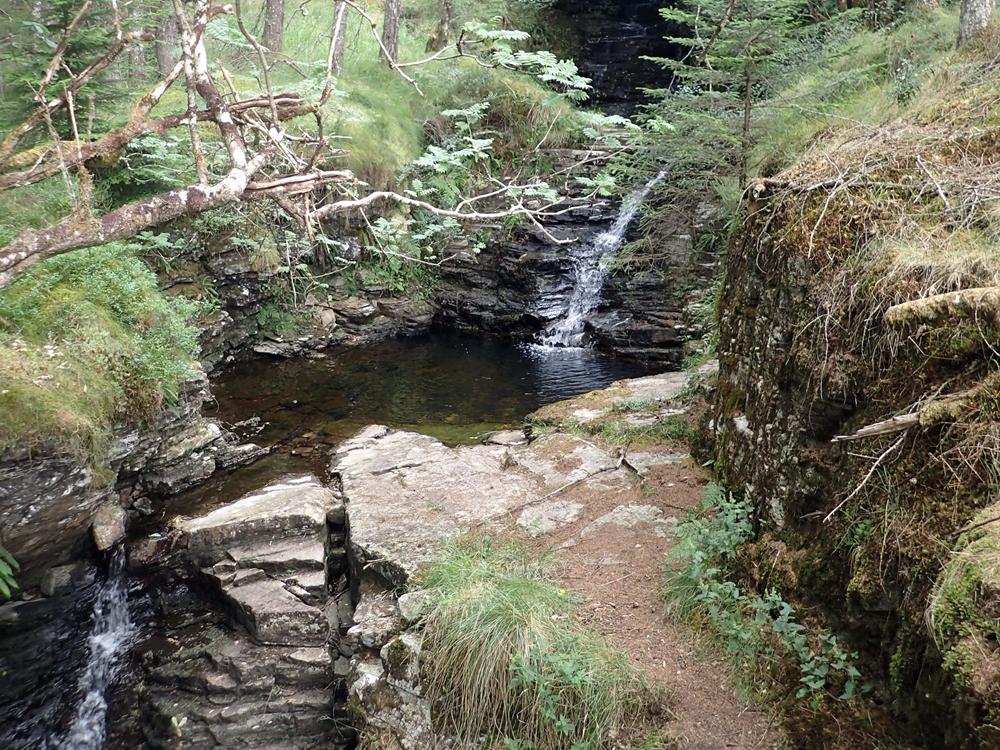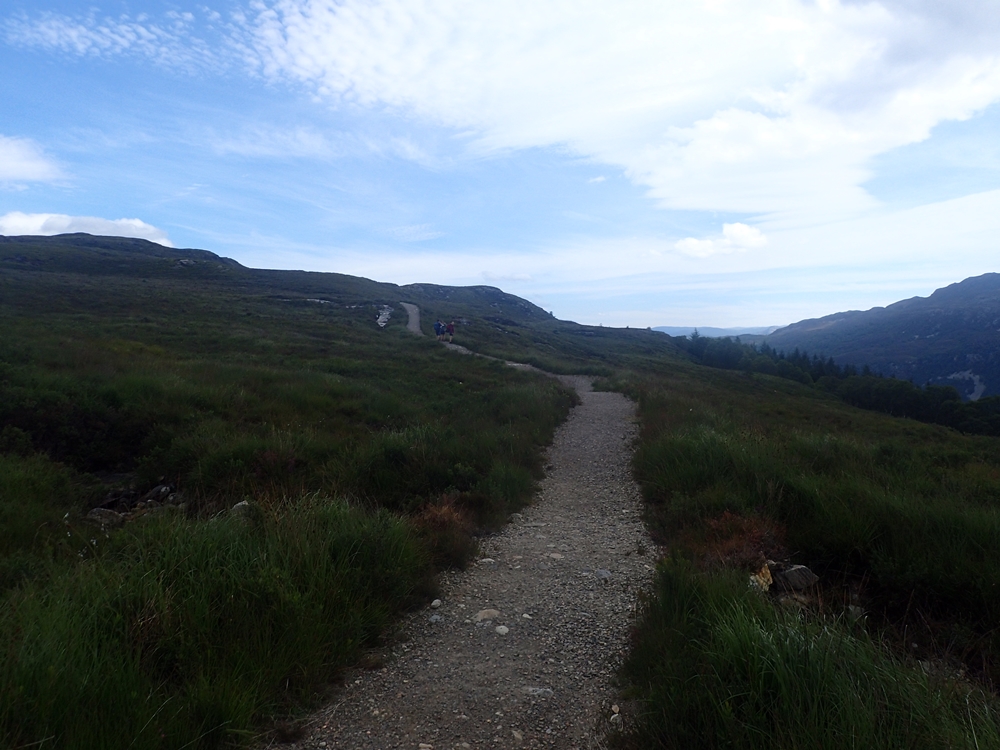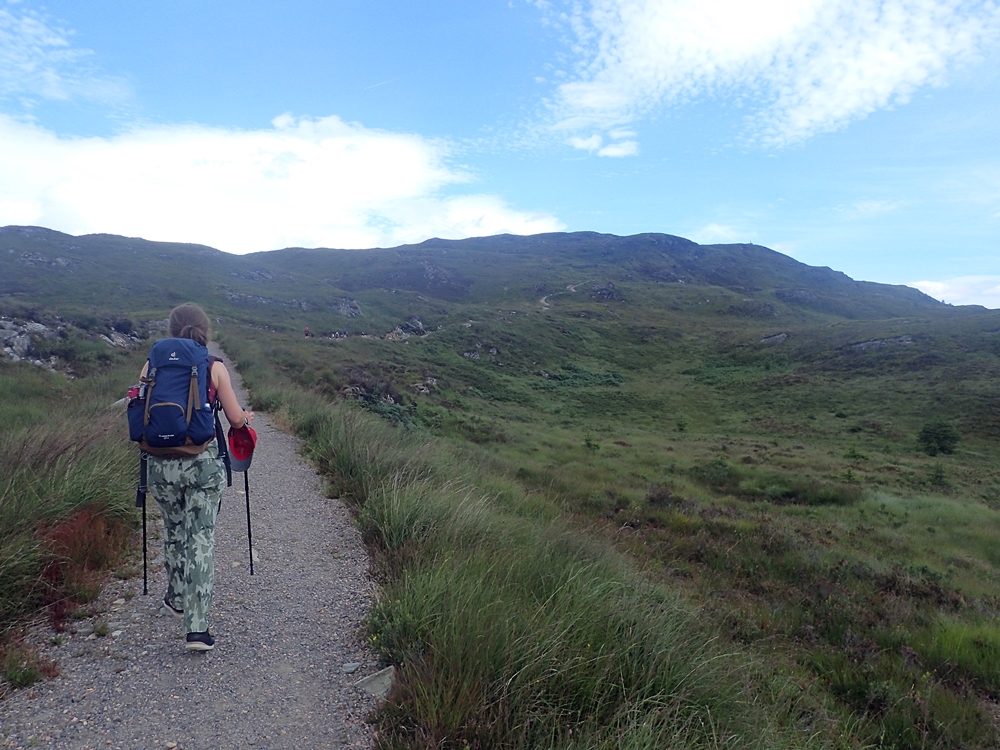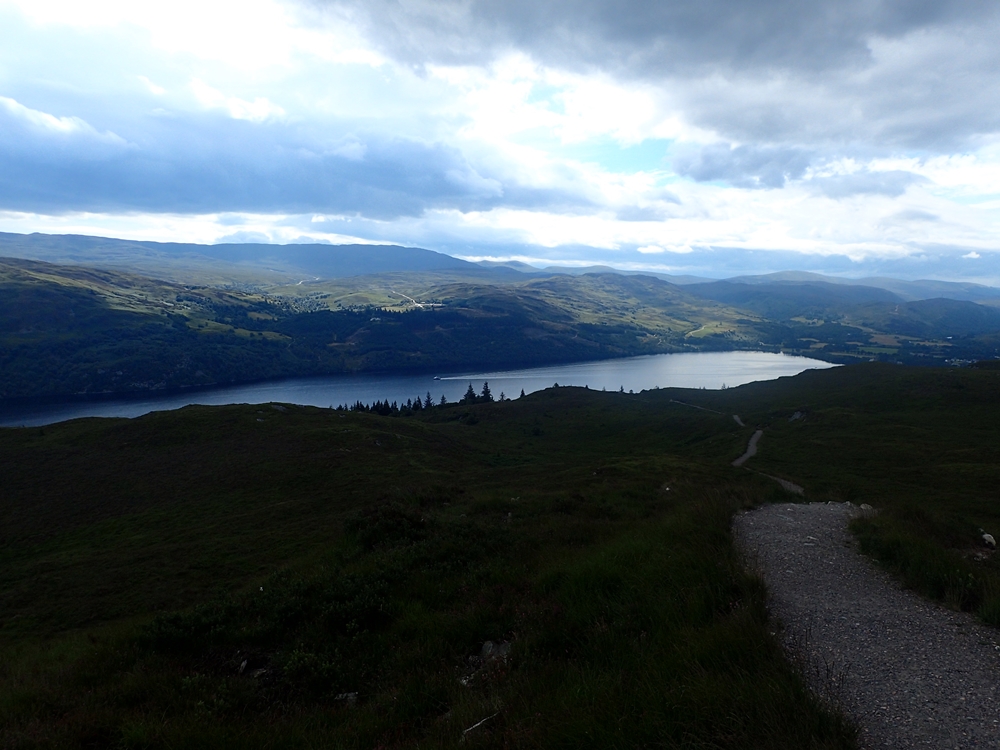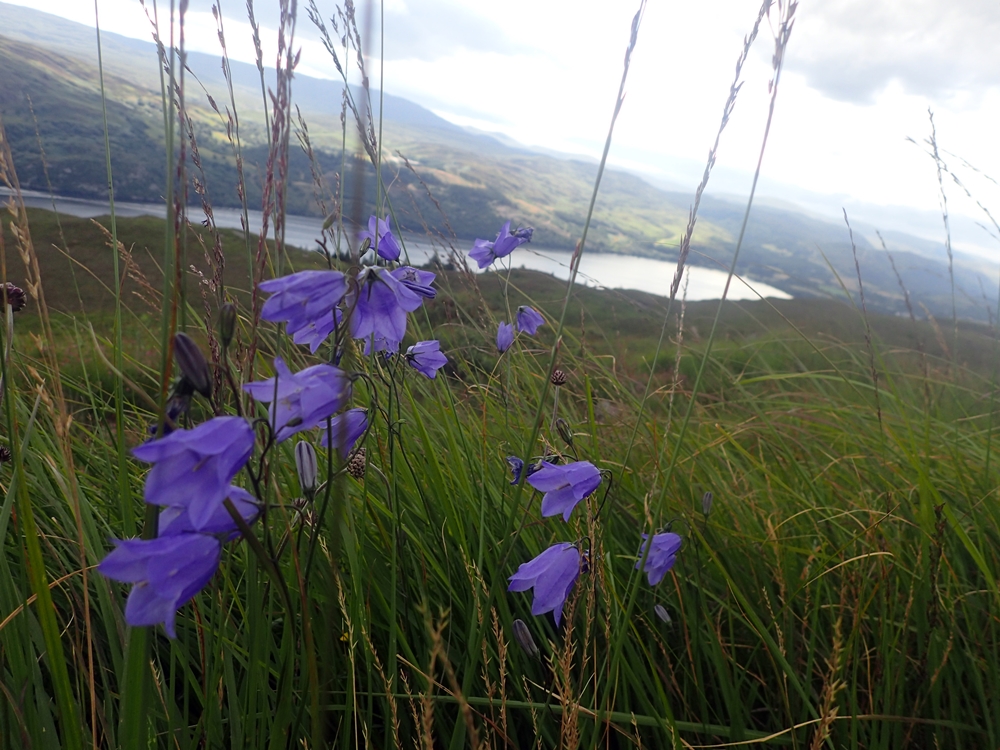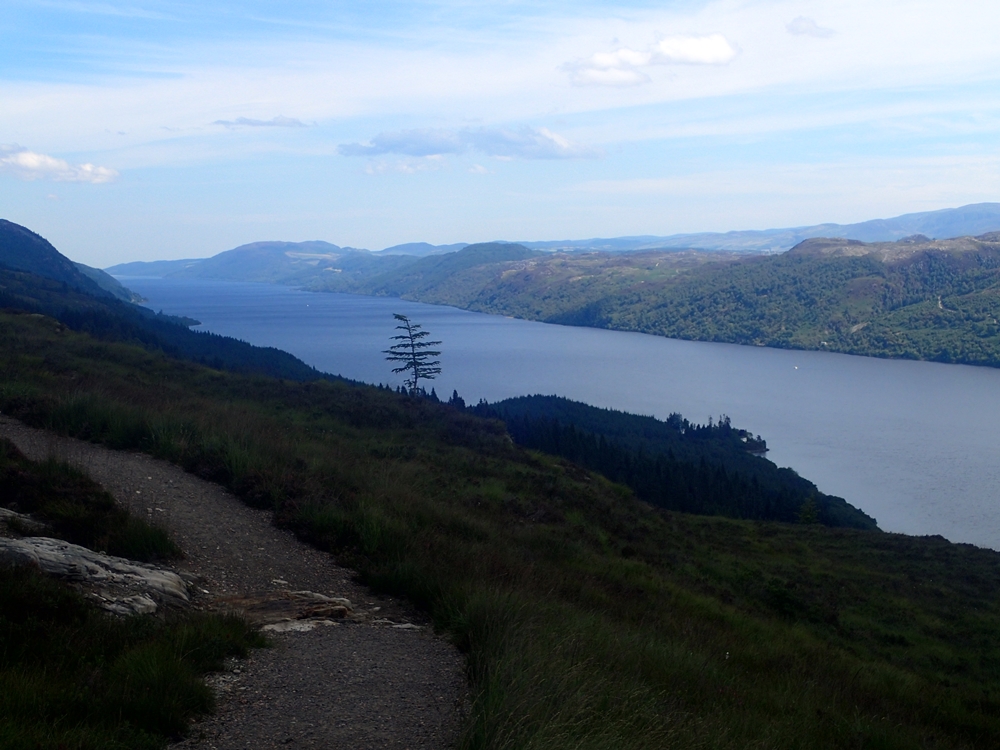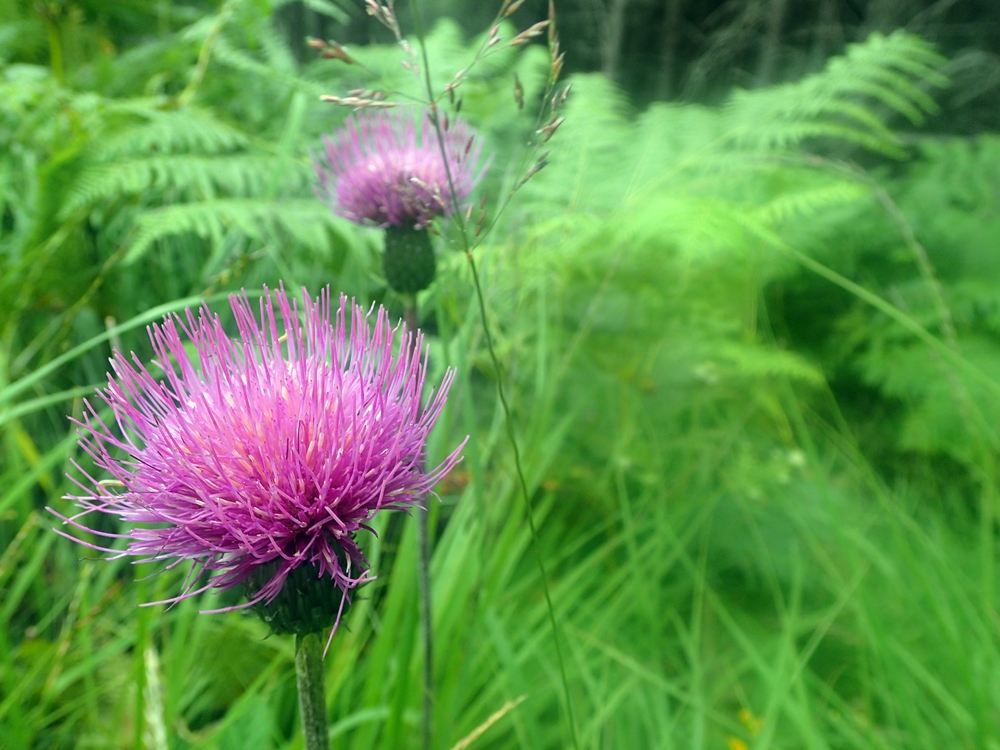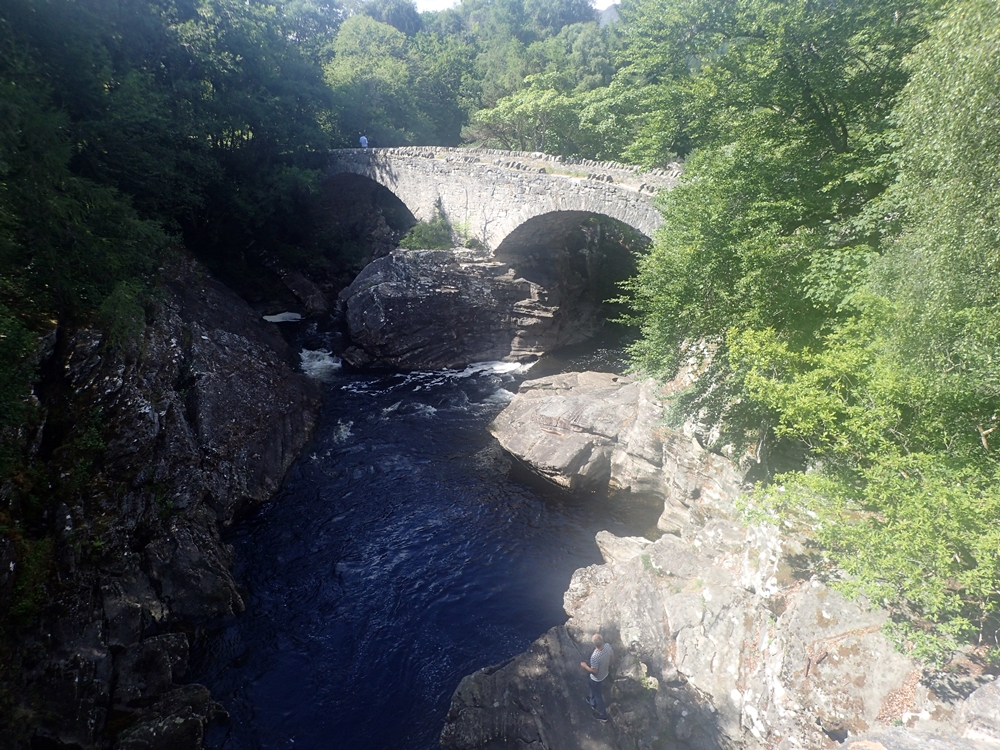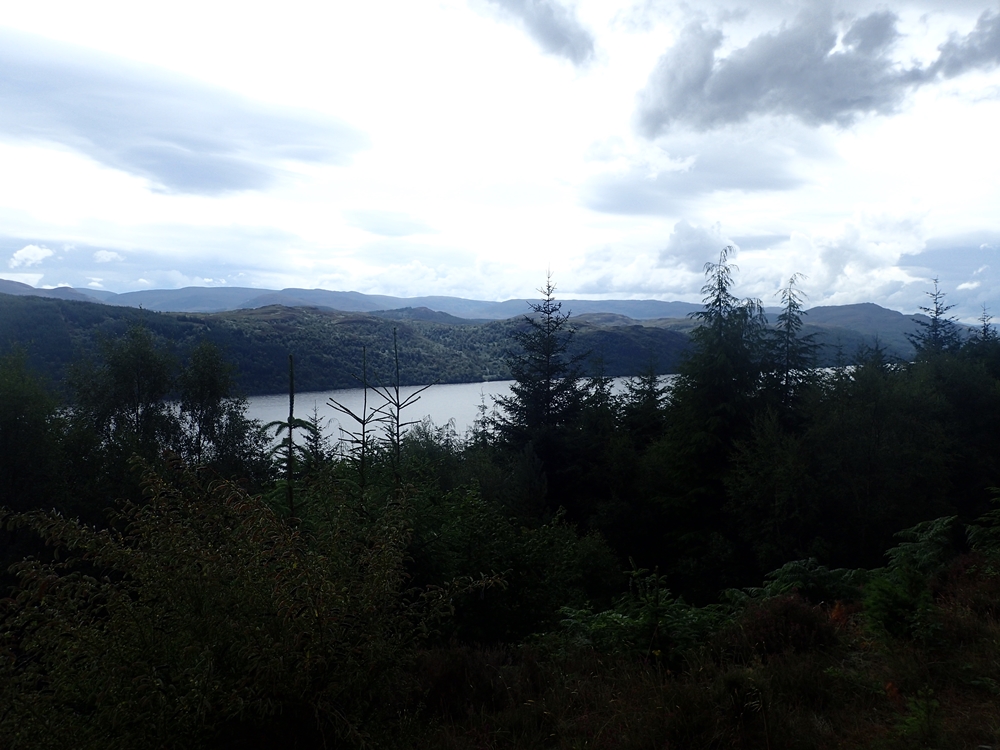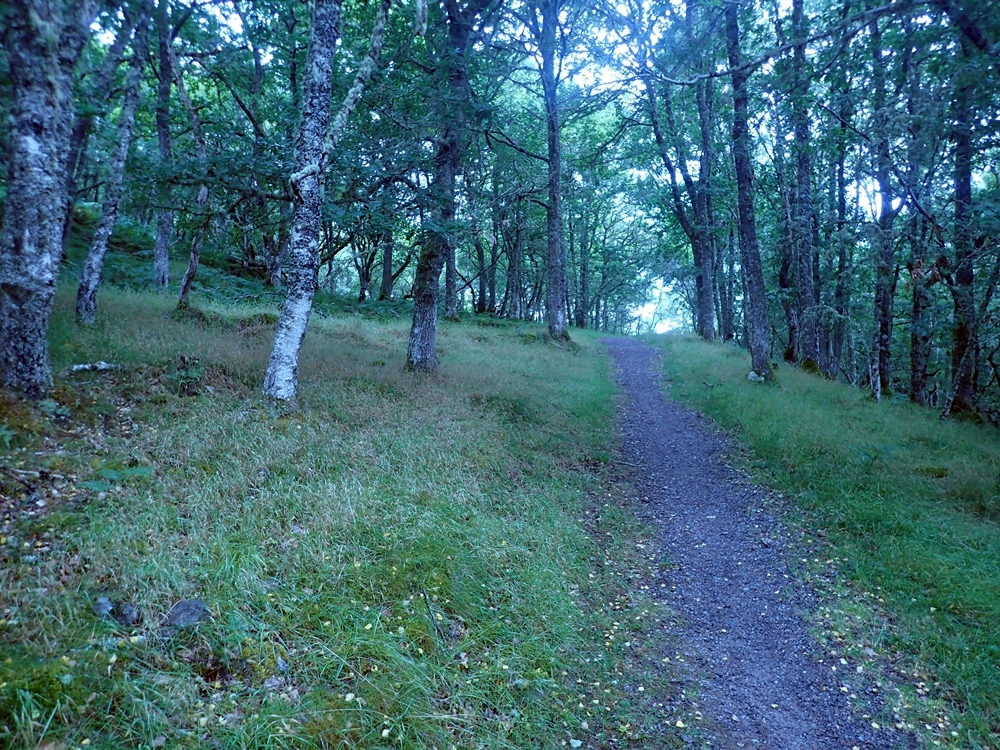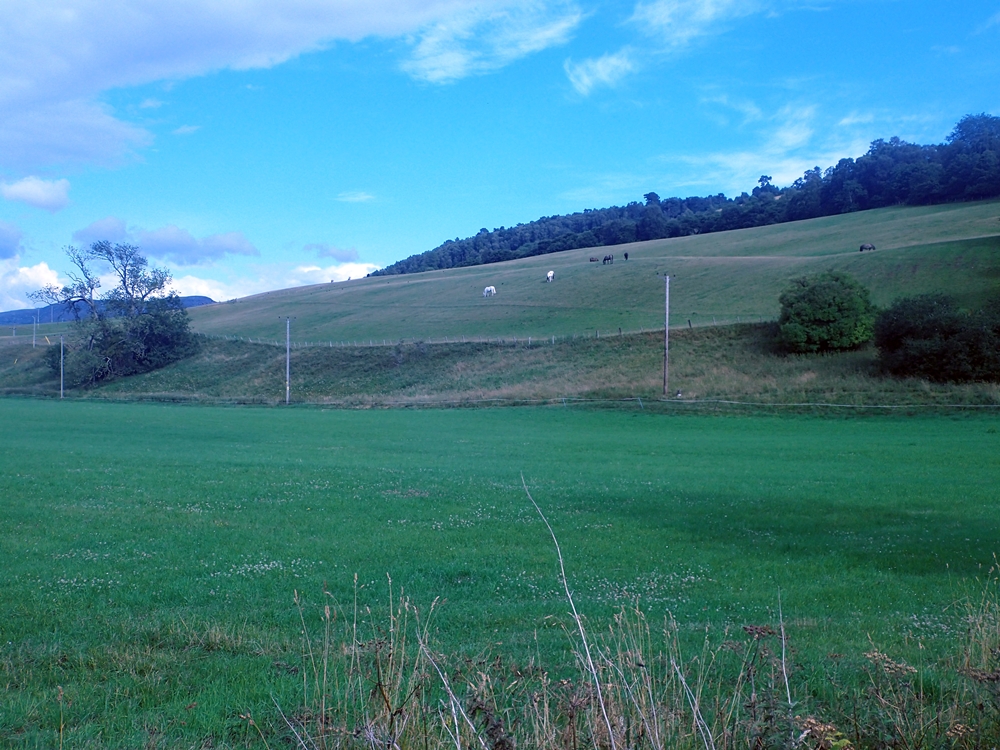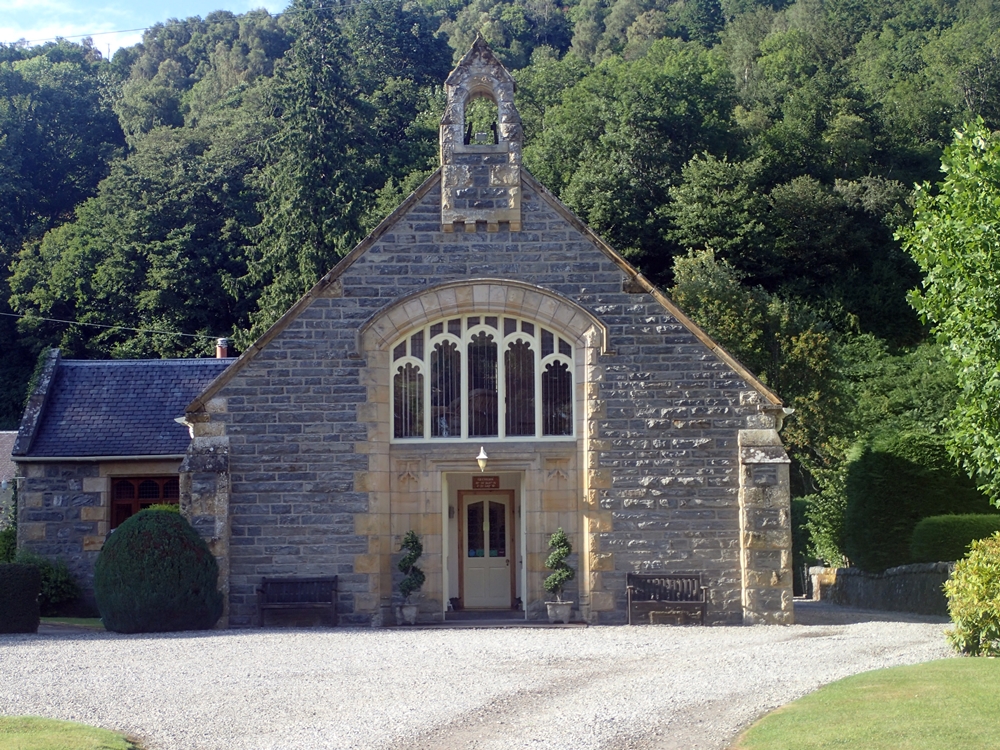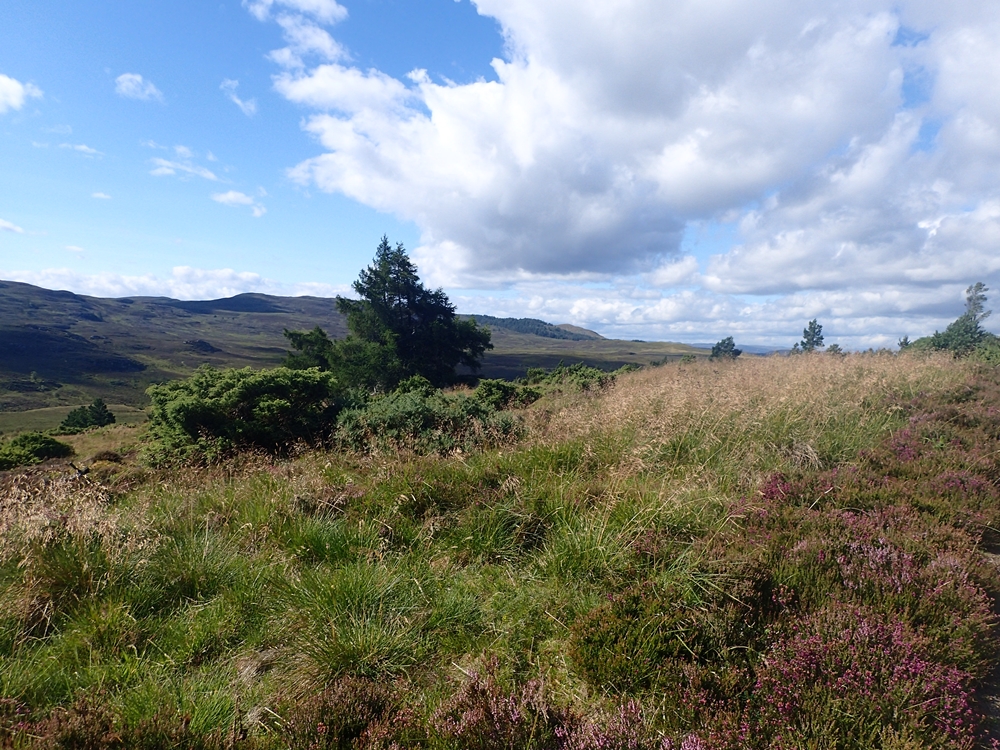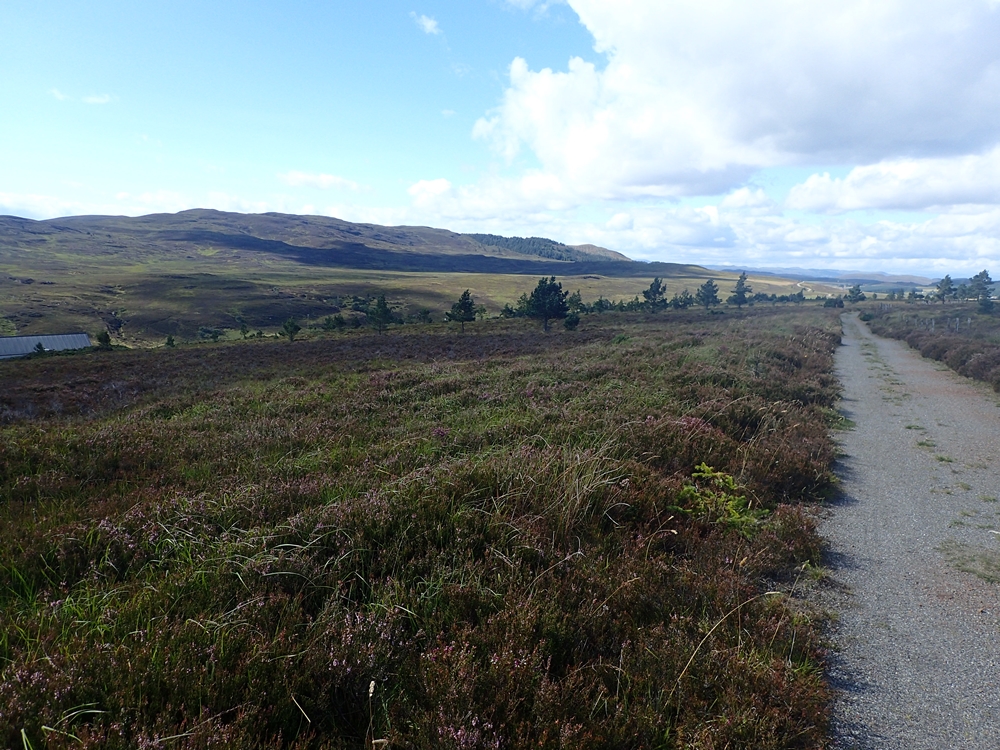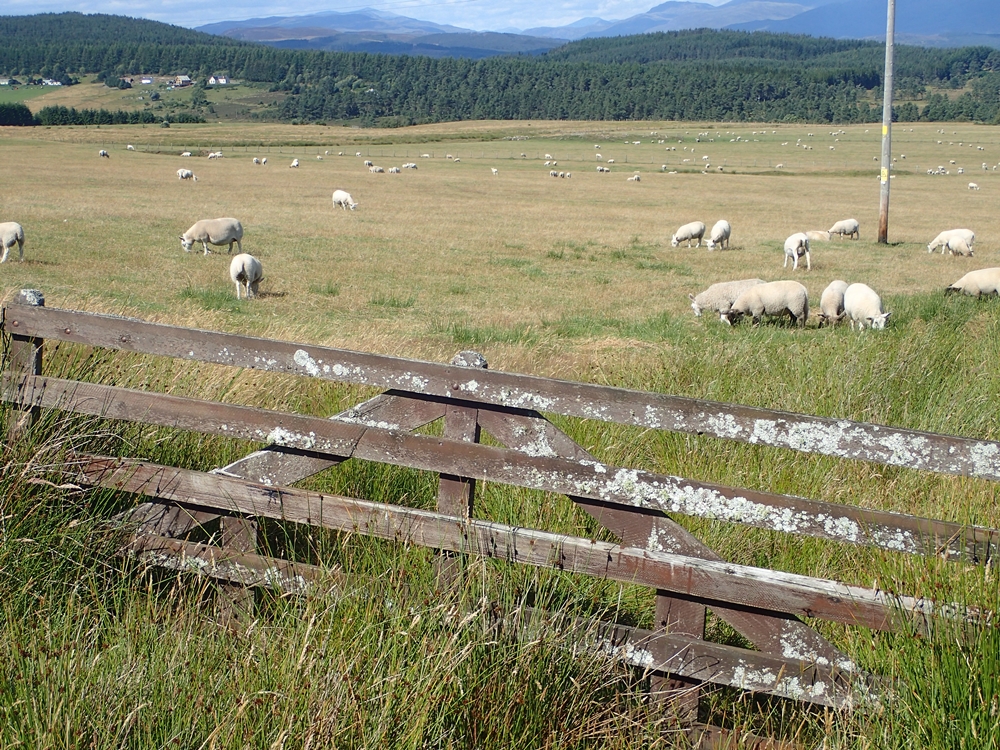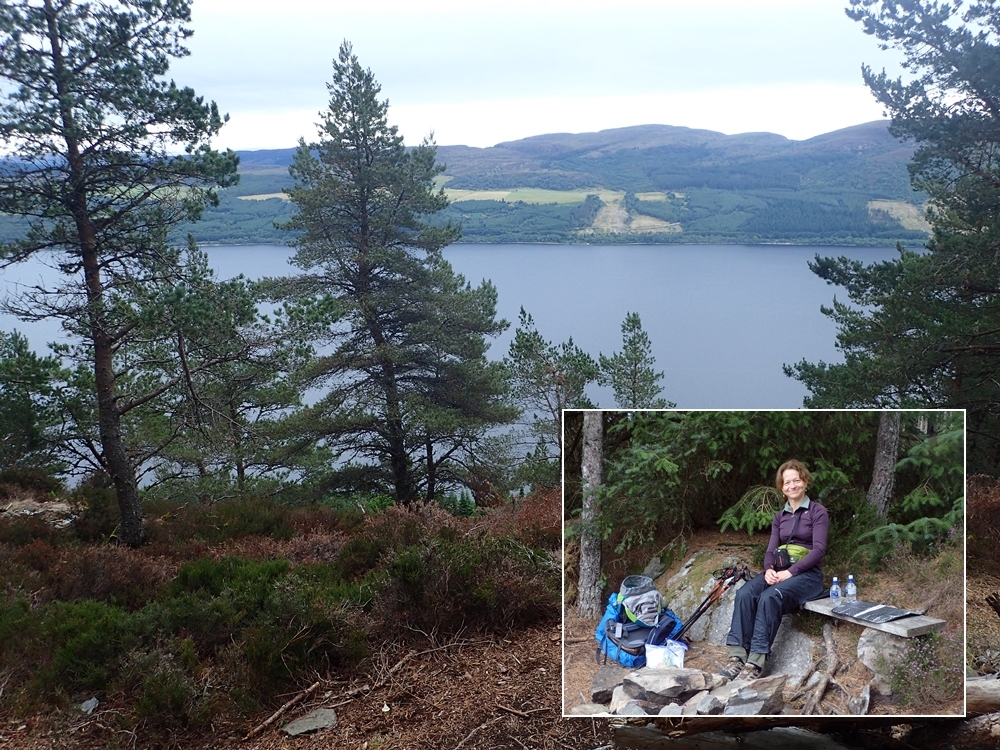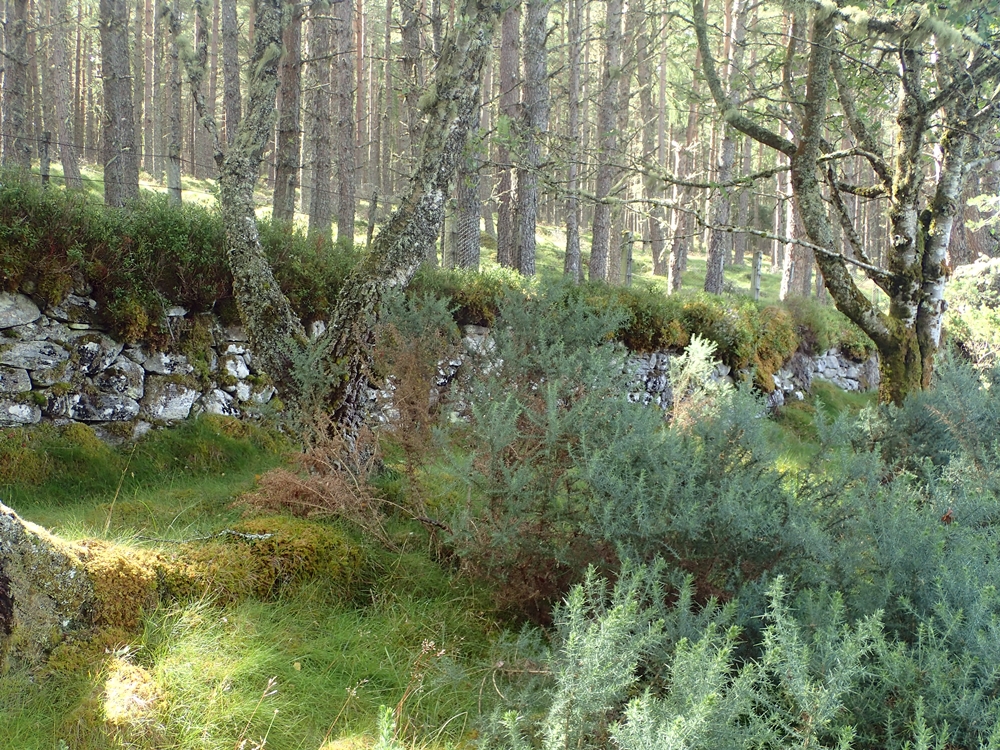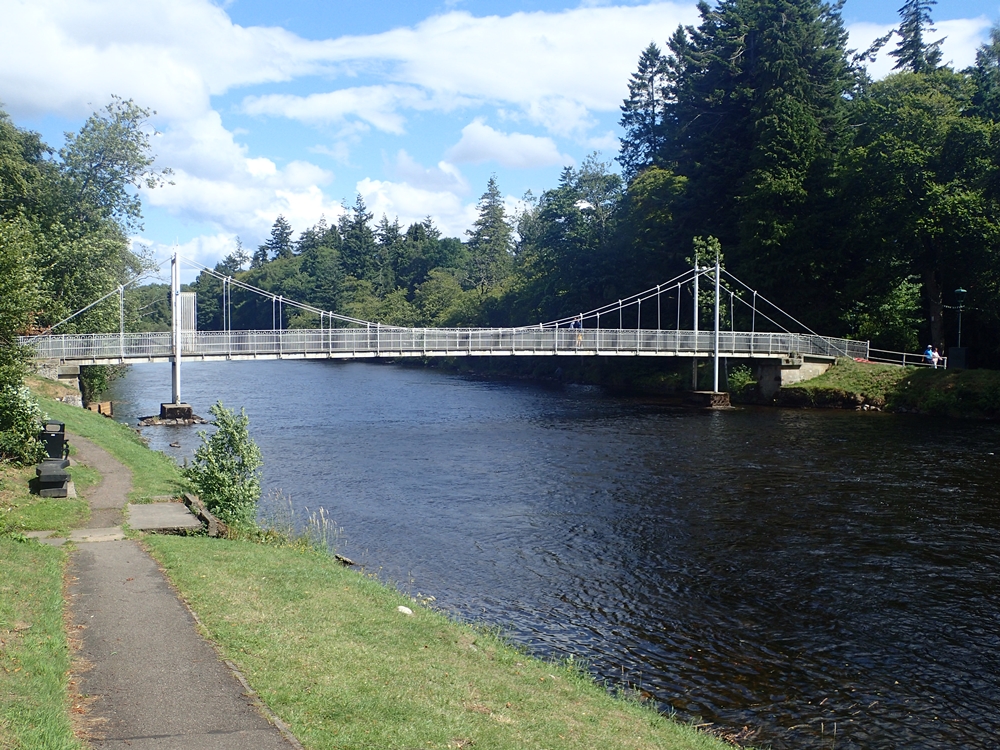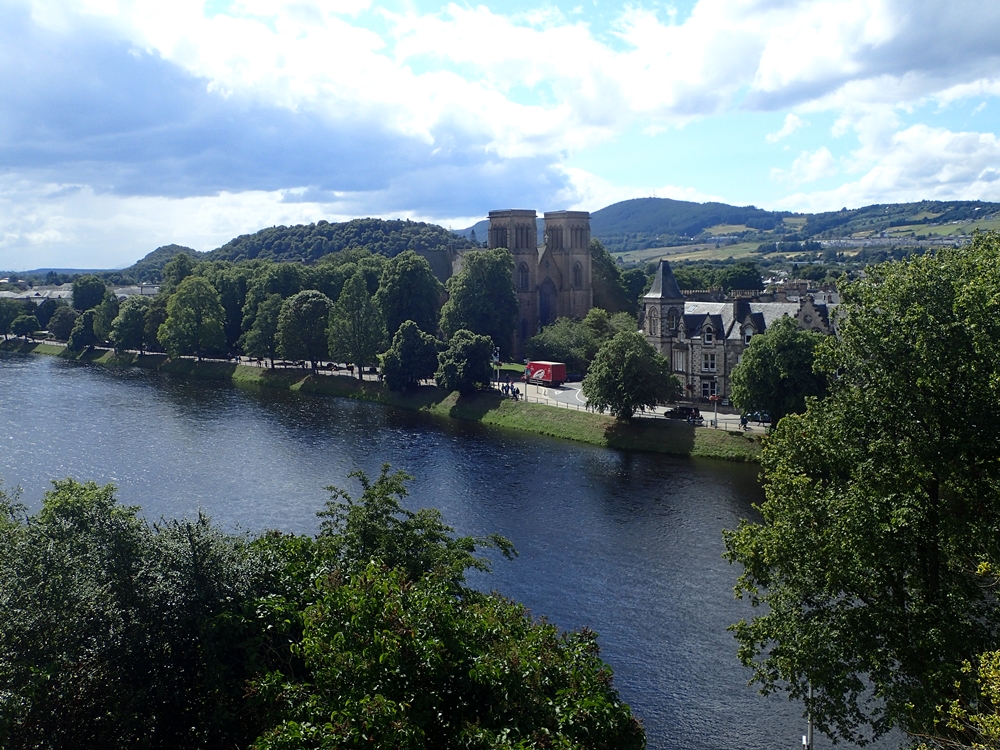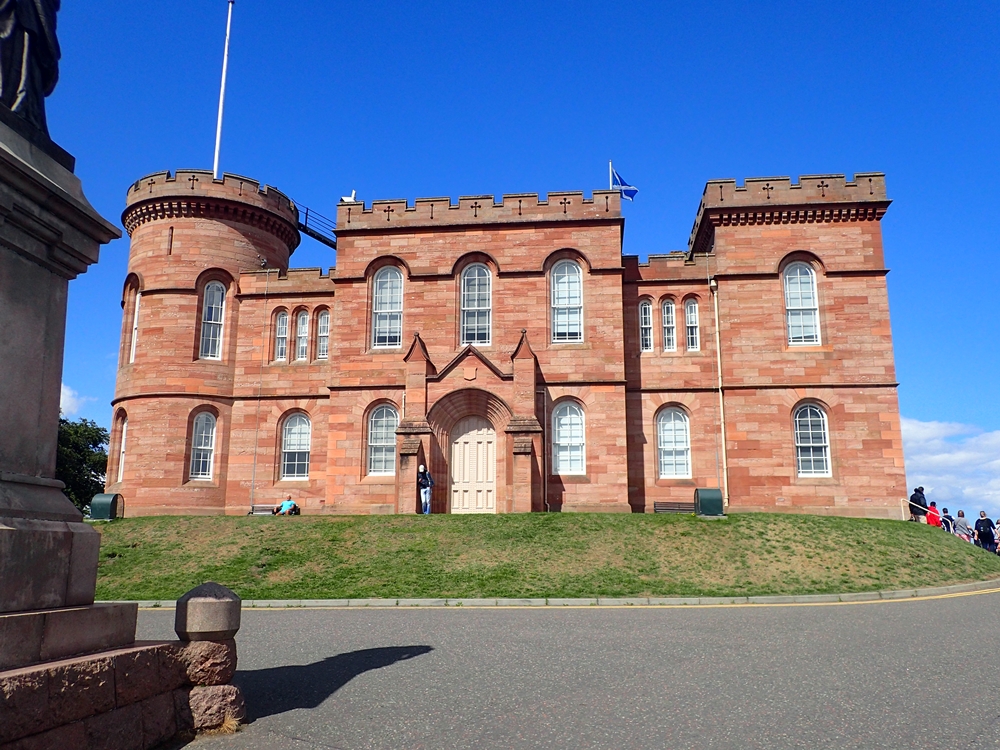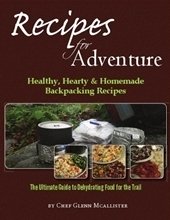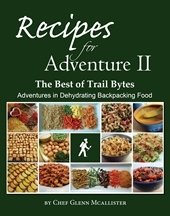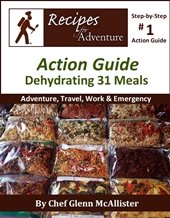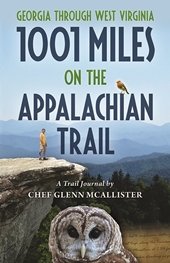Great Glen Way
Fort William to Inverness Scotland
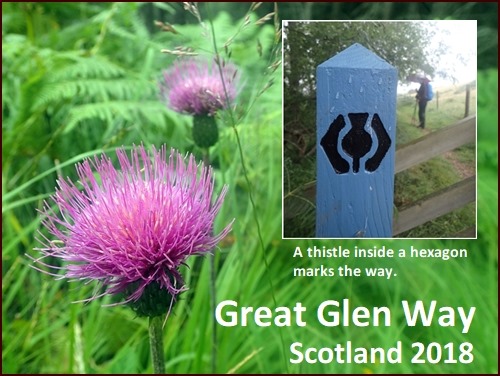
Dominique and I hiked the 79-mile Great Glen Way in Scotland the last week of July, 2018. The route runs along lochs and canals which link the Atlantic Ocean to the North Sea, starting at Fort William and ending at Inverness. The valley, or glen, was formed eons ago by the collision of tectonic plates, followed by glacial scouring during the last ice age. As we walked, the North-West Highlands were on our left, and the Grampian Mountains were on the right.
Resources:
This trip report includes links to more
information about places of interest along the Great Glen Way. We had
good experiences at all of the B&Bs and restaurants referenced.
We
carried a guide book, Great Glen Way by Jim Manthorpe, and a waterproof
map of the Great Glen Way. The guide book and map were also useful in
the planning phase.
Travel Logistics:
We flew into Glasgow the first day, then
travelled by ScotRail to Fort William the next day. The train made a
lot of stops, so the ride took four hours. The train ride from Inverness
back to Glasgow at the end of the hike took three hours.
Tip: Book your train transportation well in advance, or you might not get a seat. The trains were full.
On the advice of friends, we utilized Mickledore Walking Holidays to book our accommodations and transport our luggage by taxi from one stop to the next. That allowed us to walk with just the essentials in our day packs. For those wishing to enjoy the full backpacking experience, there are places for wild camping, as the Scots call it, along the way. The Great Glen Way can also be conquered by bicycle or canoe/kayak.
The B&Bs we stayed at cooked a full Scottish breakfast in the morning consisting of eggs, toast, bacon, sausage, baked beans, roasted tomatoes, haggis, and/or black pudding.
Haggis: A savory pudding containing sheep's pluck (heart, liver, and lungs); minced with onion, oatmeal, suet, spices, and salt.
Black Pudding: A type of blood sausage made from pork blood, pork fat or beef suet, combined with oatmeal, oat groats, or barley groats.
We liked both; our fondness of the nutty-tasting haggis increased the more we ate them. For anyone not wanting to test their digestion while on holiday, there were familiar offerings like yogurt, fruit, and cereal.
Most of the inns provided a sack lunch, or we purchased supplies in town. Two of the inns cooked evening meals. Other nights we dined in restaurants that featured Scottish specialties, such as venison, lamb, and salmon. We managed to go the whole trip without ordering fish & chips. In Great Britain, French fries are call chips, and potato chips are called crisps.
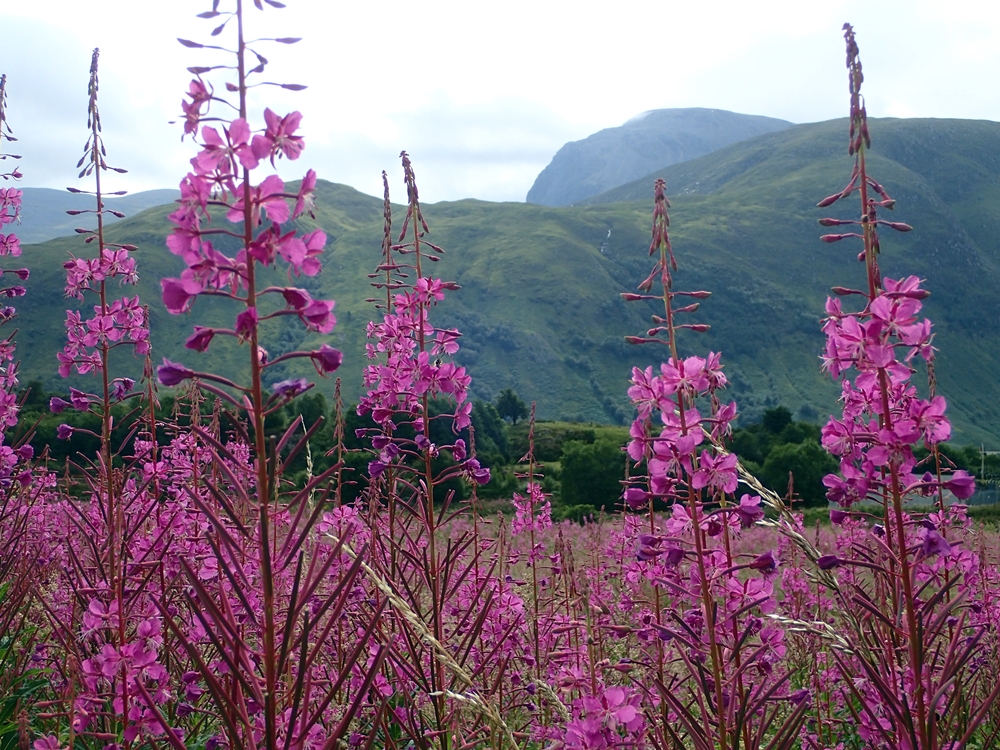
Click any of the thumbnails to view our Great Glen Way photo slide show.
Day One: Fort William to Gairlochy, 10 miles
Accommodation the first evening we arrived in Fort William: Guisachan House.
Accommodation in Gairlochy: Dalcomera
After a short walk out of Fort William, we followed along the River Lochy where it empties into the brackish water of Sea Loch Linnhe. Gulls squawked and hunted on the sandbars exposed at low tide. We passed the remains of Old Inverlochy Castle, which had been built in the strategic location near the river’s mouth, in 1280, by a wealthy Norman family. It’s a quiet place now, with mowed grass inside and weeds protruding from mortar, the stones mum concerning centuries of war and conquest which played out there.
The path turned away from the river over blacktop through a residential area skirting Loch Linnhe, then passed by Neptune’s Staircase, a series of eight consecutive locks at the southwestern end of the Caledonian Canal. For the rest of the day, we walked along the canal towpath to Gairlochy. Purple rosebay willowherb grew along the canal’s banks, the reflections on the still water occassionally rippled by a passing sailboat.
Day One’s section of the canal ended in Gairlochy where it connects to Loch Lochy. We had a splendid view from our B&B window of Ben Nevis, the highest mountain in Great Britian. Heather, our host at Dalcomera, cooked us a nice dinner.
Day Two: Gairlochy to Laggan Locks, 13 miles
Accommodation in South Laggan: Forest Lodge
Our second day had us walking along or near the shoreline of Loch Lochy. Part of the way was through forests of native birch and beech, but the greater distance was through non-native spruce trees growing like corn on conifer plantations. Forestry is the major economic driver in this region of Scotland, and most views of the mountain slopes included patches of clear-cut land with bleached out stumps. The green expanses far outnumbered the desolate swaths, and the way under the trees was shady and fragrant.
Starting around 1942, thousands of WWII Allied Troops trained in this area of Scotland for the Normandy Invasion. Along the forest path, we saw the remains of a practice landing craft. The men would have disembarked into a ditch filled with water while officers fired live rounds over their heads. Another part of the soldiers’ training was to run up and down Ben Nevis. We often had good views of Nevis, as we looked back across Loch Lochy towards Fort William.
Having walked the length of Loch Lochy, we exited at Laggan Locks and made the short, but frightful walk along the narrow shoulder of busy A82 to Forest Lodge. Lorraine, our host at Forest Lodge, cooked a tasty evening meal.
Day Three: South Laggan to Fort Augustus, 12 miles
Accommodation in Fort Augustus: Holt B&B
We returned to the canal along scary A82 in the morning only to realize that we had forgotten our hiking poles. Dominique waited with my pack, while I sprinted back to retrieve them. The canal shortly joined with Loch Oich where we walked just above water level along an old railway line through a strip of lowland, native forest.
Once Loch Oich was behind us, we hopped back on the Caledonian Canal for the rest of the day. After a couple of hours, we wished we were on bicycles. The scenery along the canal, while pleasant, did not change much. Finally, the canal deposited us in Fort Augustus at the southern end of Loch Ness.
Cruise boats were ready at the dock, with the latest sonar equipment, to take tourists out for a possible sighting of Nessie, the Loch Ness Monster. Far from just a modern day hoax, tales of the Loch Ness Monster go back to the end of the 6th century. Saint Columba, a revered holy man in Scotland’s history, was said to have had words with the beast, which were written down about a hundred years later by Columba’s biographer, Abbot Adomnàn, in his Life of Columba:
“When Columba reached the river bank, he saw a poor fellow being buried; and the buriers said that, while swimming, the man had been seized and most savagely bitten by a water beast. Notwithstanding, the holy man ordered Lugne, one of his companions, to swim across to the other side and bring back a boat. Lugne obeyed without delay, but the monster suddenly swam to the surface and with gaping mouth and great roaring rushed towards the man mid-stream. While all there were struck down with extreme terror, the blessed man raised his holy hand and commanded the savage beast: `Do not touch the man; turn backward speedily.’ The beast, as if pulled back with ropes, fled terrified in swift retreat.”
A great restaurant in Fort Augustus, situated right on Loch Ness: Boathouse Restaurant.
Day Four: Fort Augustus to Invermoriston, 9 miles
Accommodation in Invermoriston: Craik Na Dav
Today, we left the flat walking behind and took to the high route. The trail zigzagged up through a forest of huge deciduous trees and native Scots pines. We walked past secluded waterfalls and streams. Eventually, the trees gave way to grass, heather, and juniper bushes. Views opened up looking down over the tops of Scots pines to Loch Ness. Trees became sparce as we climbed up and across the open moorland.
We decended back through forest the last few hours into Invermoriston. Along the road walk, we passed the Telford Bridge, which had been built between 1805 and 1813, by Thomas Telford, the same man who designed the Caledonian Canal – completed in 1822. At Craik Na Dav, where we stayed, there were bird feeders in the yard along the edge of the woods, that attracted birds of all kinds, including pheasant. Other visitors were native red squirrels, which have been largely displaced in most of Great Britian by the non-native grey squirrel from North America.
A great restaurant in Invermoriston: The Glenmoriston Arms Hotel. Reservations recommended.
Day Five: Invermoriston to Drumnadrochit, 15 miles
Accommodation in Drumnadrochit: Glenkirk. We stayed here two nights.
After enjoying a hearty Scottish breakfast at Craik Na Dav with a family from Germany, we ascended out of town back into the forest. We intended to take the high route again, but a sign said the route was closed due to blown down trees on the way up. The low route passed through a conifer plantation, with occasional views down to Loch Ness. We encountered one small deer on the path. It scampered up the embankment when we got close, but remained there to observe our passing.
It rained lightly for part of the day, and it seemed that every time we raised our umbrellas, the rain stopped. Dominique and I were quite happy in the misty, cool environment of the forest. The air is rejuvenating there. If the midges were going to come out, this would have been the day. Luckily, all it takes to keep the tiny biting gnats at bay is a breeze of 5 mph, and, as we ate our lunch under our umbrellas, perhaps we had 6 mph of deterrence going by.
The last three miles were on the road through moorland, pastures, and finally the bustling community of Drumnadrochit. The scenery was nice, but walking the tarmac was hard on our feet. Our B&B was up a hill on the far side of town. We walked by Nessieland, a tourist attraction where a recording of Amazing Grace, bagpipe rendition, could be heard out the open door.
A great restaurant in Drumnadrochit: Fiddler’s. Reservations recommended.
Day Six: Blackfold to Drumnadrochit, 12 miles
For people who hike the Great Glen Way in six days, the last day covers twenty miles. We elected to hike seven days, so our last two days were twelve miles and eight miles respectively. Our taxi drove us north, to Blackfold, in the morning, and we hiked back south to Drumnadrochit.
Starting out, we were further west of Loch Ness than the previous two days. The land was a mix of bog, moor, and pasture. Along the Great Glen Way, where there are not lakes or forests, you will find sheep. Sometimes we could see hundreds of the little white wool balls dispersed far up the mountains. Today, we were close enough to listen to the lambs bleating, as we walked two miles on a one-lane country road along fenced pastures.
For the latter part of the day, we passed back into conifer plantation land, and drew closer to Loch Ness. Dominique found a great little spot overlooking the loch for our lunch break. We would have lingered longer, but the midges began to make their presence known. The final mile back to Drumnadrochit was on the main road, which fortunately had a sidewalk.
We spent a second night at Glenkirk. It was once a church that had been built in the early 1900s. The owner, Ross, who is a carpenter, masterfully converted the church into a B&B thirty years ago. He and his wife, Fiona, were wonderful hosts. Glenkirk was our favorite accommodation of the walk.
Day Seven: Blackfold to Inverness, 8 miles
Accommodation in Inverness: Craigside Lodge
After our second hearty breakfast cooked by Fiona, which included both haggis and black pudding, we returned to Blackfold by taxi, to finish the last eight miles to Inverness. We walked though forest for about five miles, a good stretch of it along a rock wall that looked like it had been there a long time. We were back in civilization for the last three miles, passing through a residential area of Inverness. The last bit of the Great Glen Way meandered through a park along the River Ness, and came to its end at Inverness Castle. We toasted with a pint of local brew at the pub across the street, before walking up the hill to Craigside Lodge.
Great restaurant in Inverness: The Mustard Seed. Reservations recommended.
Great Glen Way Impressions
The Great Glen Way offered beautiful vistas of the Scottish Highlands,
countryside, and waterways. Other than where the way traversed the high
route between Fort Augustus and Invermoriston, the path was level and
wide. Most of the walking in woodlands was along gravel-topped forest
service roads. A good bit of the walk, particularly the first three days
on the way to Fort Augustus, was along the towpath of the Caledonian
Canal. There was also a fair amount of road-walking, when the way passed
through towns.
We were never far from civilization, but often we
walked with no other people in sight. Sheep far outnumbered people.
Just as counting sheep brings sleep at night, watching the gentle
creatures graze in pastures brought us peace by day. Skippers steered
their sailboats amicably on the canals, hardly stirring a wake. We
enjoyed talking to fellow travelers, on the trail or at the breakfast
table. They hailed from the Netherlands, Belgium, France, Denmark,
Germany, Great Britain, and America. Our hosts were very friendly, and
their Scottish accents somehow felt at home in my ears.
After
spending seven days in the fresh pine-air of Scotland, our soul-clocks
reset by the unhurried pace of walking, we returned home rejuvenated.
Hiking the Great Glen Way will forever remain one of our most enjoyable
holidays, and we are eager to explore more of Scotland.
Scottish Roots
Our hike of the Great Glen Way was a birthday gift from Dominique. In going to the country of my roots, where Clan MacAlister formed in the thirteenth century, I wondered if, after thirty or so generations had passed, I would feel some soul-level connection to Scotland.
Yes, indeed. My Scottish ancestors loved the lands and seas which sustained them. I feel inspired in the same way, whenever I walk in a forest or paddle down a river. And then there is that independent streak that Dominique noticed in my character soon after we met. That’s a well-known Scots trait. So is loyalty to relations built on trust.
And what about the spirit of adventure? At least one, perhaps two, of my genetic forebears left Scotland for a new life across the ocean. I don’t know when, why, or how, but that’s an adventure story I’d like to hear.
Trip details fondly recalled by Chef Glenn McAllister.
Share this page with friends on social media.
Free E-book & Newsletter
Free with Trail Bytes subscription.
Dehydrating Food from A–Z

